Ontario’s forests, meadows and waters provide an incredible range of nutritious and delicious edible wild plants. Ontario Nature has prepared this foraging guide as an introduction to this local resource, and to encourage people to get outside and experience the wonders the natural world provides.
The native and naturalized trees, shrubs, herbaceous plants and fungi listed in this guide are a sample of some of the abundant local species that can be harvested sustainably in Northern Ontario, though there are many other wild edibles to explore. The guide is intended to be a starting point for people interested in foraging for edible wild plants and should not be considered to be a definitive resource for their identification and use.
Basic Rules for Harvesting | Sustainable Harvesting | Caution | Disclaimer | Acknowledgments | Resources
Trees | Shrubs | Herbaceous Plants | Fungi
Basic Rules for Harvesting Edible Wild Plants and Fungi
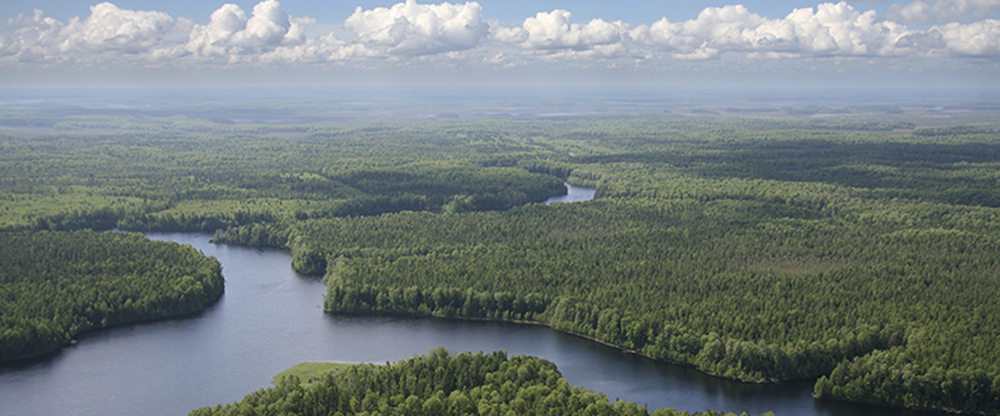
Harvesting edible wild plants can be a fun, educational and sustainable activity for all ages if it is done properly. Ontario Nature has identified some basic rules for harvesting wild plants to ensure the safety of participants and the sustainability of plants involved.
- Be sure you know what you are harvesting, and eat only plants you can positively identify as edible. Learning about plants from a local expert, consulting books and taking courses or workshops are recommended (see the resources at the end of this guide).
- Harvest plants in areas where you know the risk of contamination from industrial and other pollution is low.
- Eat only a small quantity of any plant you have not eaten before and assess how it affects you before eating more.
- Although foraging for edible plants is permitted on most public land in Ontario, obtain permission from the owner before collecting plants on private property. Another best practice is to obtain permission from the local First Nation community before harvesting on traditional territory.
- Management goals vary for protected areas and nature reserves. Ensure that wild food foraging is permitted in these areas before harvesting.
- Most importantly, take only what you can use and use what you take. Edible wild plants are a shared resource. Users of them must take responsibility for ensuring that they will continue to thrive year after year.
Sustainable Harvesting
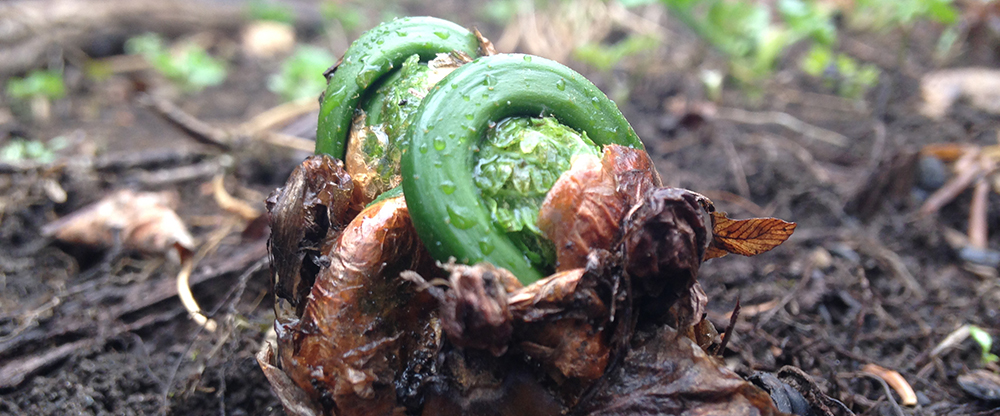
Improper harvesting techniques and overharvesting can have a significant negative impact on the ability of a species to reproduce. This practice can lead to the disappearance of a species from an area and the loss of a local food source, affecting both humans and other species. A general rule is to harvest only 5 percent of any individual patch of a species and only collect from patches within a maximum of 25 percent of a total area. For example, collecting a small handful of berries from every fourth plant on a hillside. Following this guideline helps ensure that the plants are able to reproduce. For plants that have a long life cycle and take many years to grow to maturity, sustainable harvesting entails picking even less.
Ideally, people will become exceptional stewards of Ontario’s natural areas. Sustainable harvesting methods relating to trees, shrubs, plants and fungi vary, so in some cases additional research may be required to ensure sustainability. The timing of harvesting is also important, as some parts of a plant (such as flowers or fruit) are not available year-round, while others (such as tree needles) are. Not taking more than is needed at one time is also important, as taking too much reduces available resources for other users and contributes to increased waste of these resources. Harvesting too much can also impact a species’ ability to grow and reproduce.
Practicing sustainable methods of harvesting the species listed in this guide is crucial to minimizing human impact on them and other species that rely on them. Such methods contribute to increased food security and independence, which are particularly important in communities where healthy foods are not always available or easy to obtain.
Foraging Caution
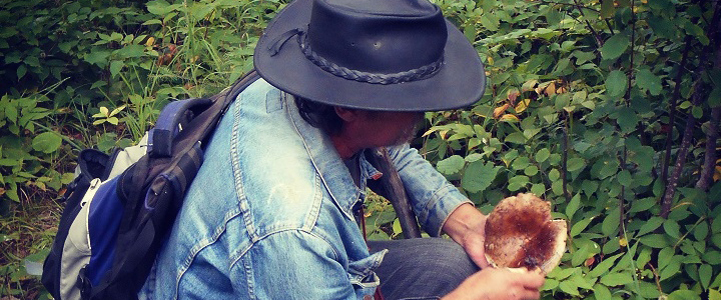
If you are uncertain about the identification of a species, before consuming it consult additional field guides and expert sources to confirm what it is. Experts suggest that if you have not eaten a plant before, try only a small sample of it; people’s responses to even known edible species may vary. When you use a plant for the first time, allergic reactions or other sensitivities may occur; if they do, consult a medical professional. Indigenous peoples have traditional medicinal uses for some of the plants mentioned in this guide, and many of these uses have been included in the text. Consult a medical professional or expert Indigenous knowledge holder before using any plant for medicinal purposes.
Foraging Disclaimer
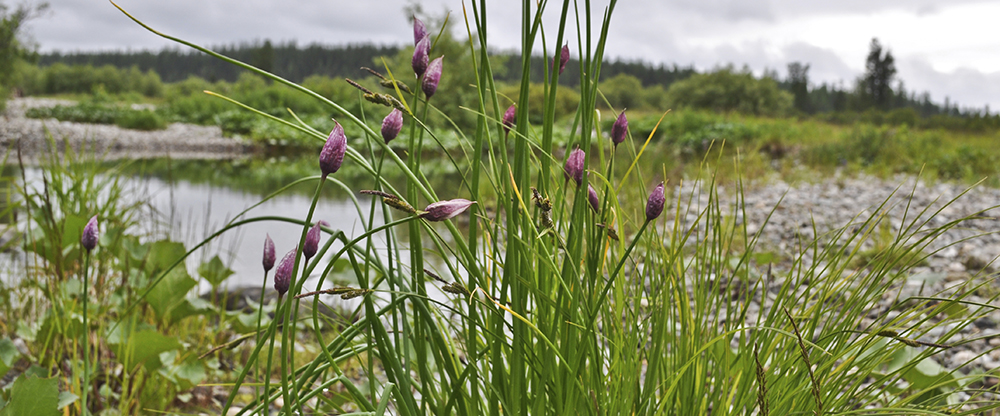
Ontario Nature takes no responsibility whatsoever for any adverse health effects due to the consumption or other use of any plant described in this guide. It is intended to provide general information only. Check with your healthcare provider before using wild plants to treat any medical condition. Before consuming any wild plants, you should be absolutely certain of their identification. Seek expert advice and use at least two reputable field guides to confirm the identification of a species. Be extremely cautious about look-alike and poisonous species.
Trees
Eastern White Cedar (Thuja occidentalis)
Identification
- Large conifer tree with rough, crumbly bark
- Leaves scaly and very fragrant
Location
- Moist areas in forests and swamps or near water
Harvesting Time
- Year-round
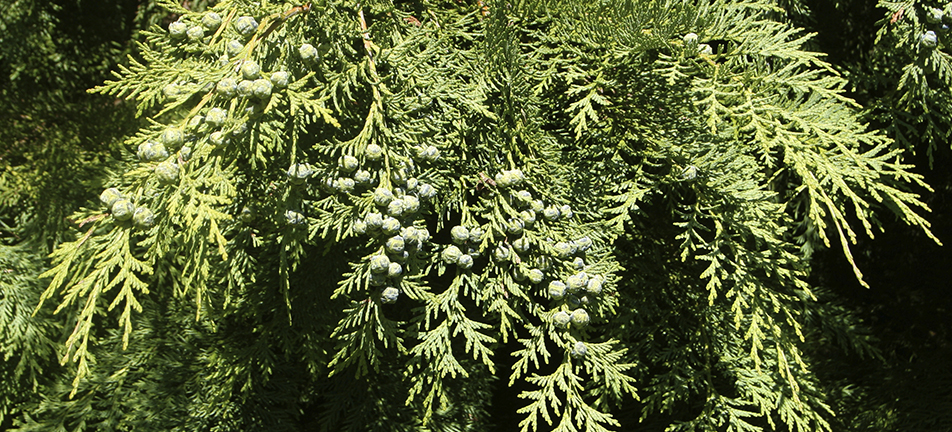
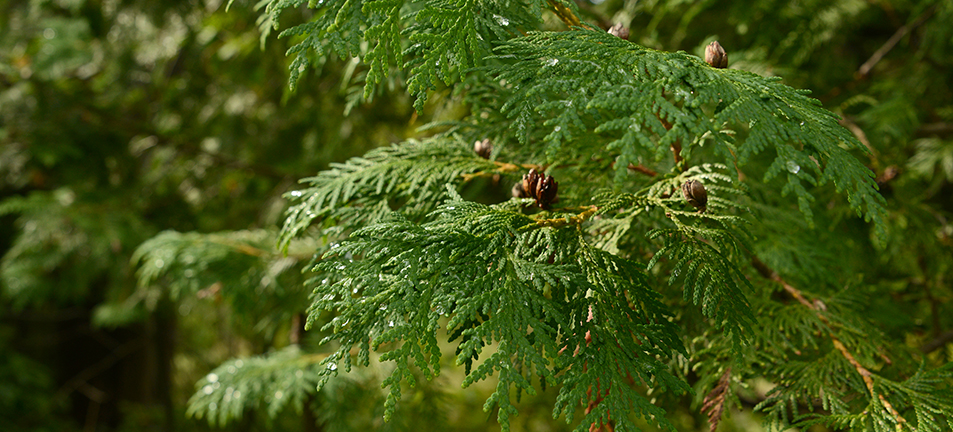
Uses and Related Information
- Tea made from the leaves is said to soothe the throat, and tea made from the bark is said to aid kidney function
- Soaking in bath water containing cedar leaves is said to soothe rashes, skin irritation and shingles
- Cedar oil can be produced by putting the cedar buds/tips in a jar with olive oil and letting it sit, sealed, for 4-6 weeks. Some people use this oil to treat warts and cold sores, and as a natural insect repellent
Cautions
- Consume only a small quantity, because cedar leaves release small amounts of toxins
Jack Pine (Pinus banksiana)
Identification
- Short needles in clusters of two that are not twisted together
- Cones closed and tight to the branches
Location
- Throughout boreal forest, but also in some open areas
Harvesting Time
- Year-round
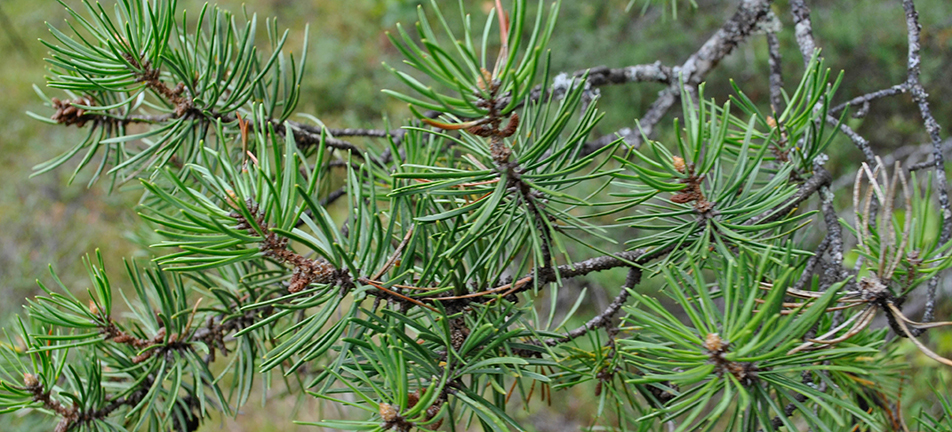

Uses and Related Information
- Some people use the needles to prepare tea high in vitamin C (honey or cinnamon may be added to mask the bitter taste)
- Some people chew the raw pitch to treat sore throats
- Some people warm the sap and apply it externally as a salve which is said to relieve joint and muscle pain, swelling, bites, burns and irritations
Cautions
- Do not eat this plant if you are pregnant (can cause miscarriage)
Paper Birch (Betula papyrifera)
Identification
- Older bark white and papery, younger bark smooth
- Triangular leaves with toothed margins
Location
- Sunny, moist areas
Harvesting Time
- Spring to fall
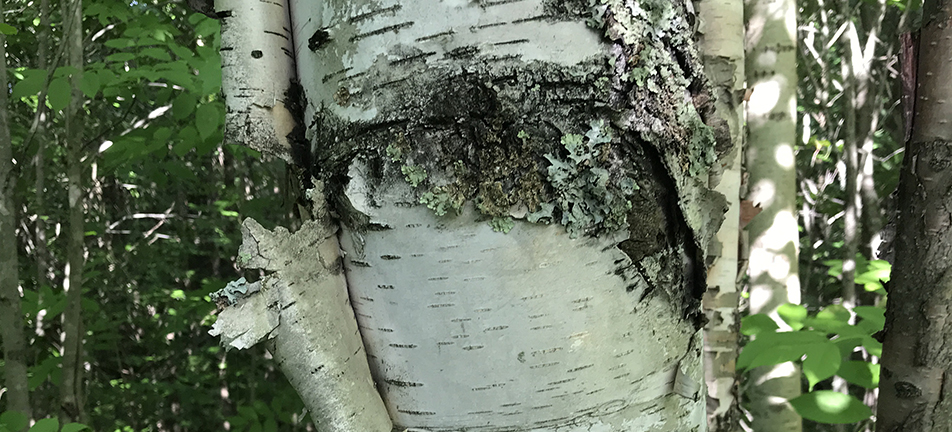
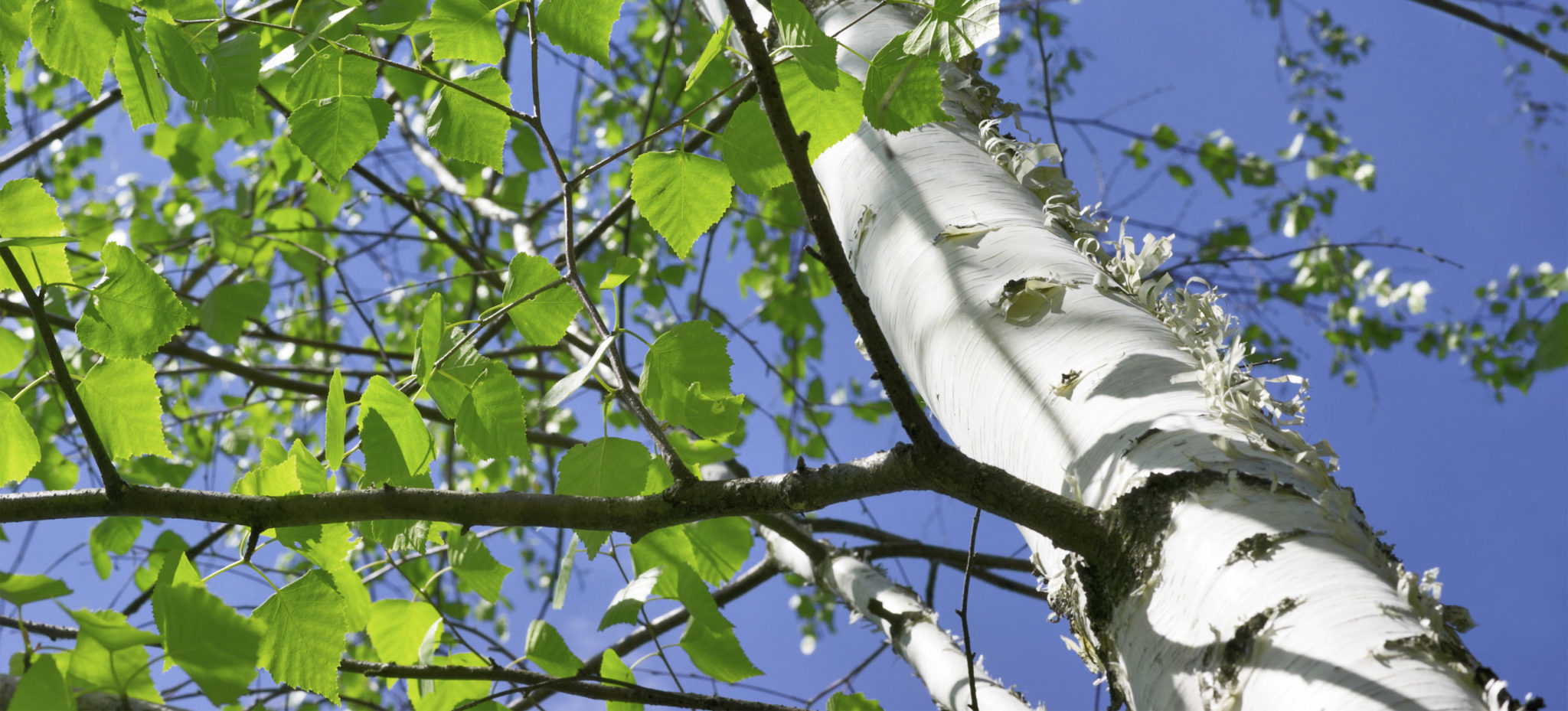
Uses and Related Information
- Sap can boiled to reduce it to a syrup, which has half the sugar of maple syrup and is more savoury (tastes similar to soy sauce or Worcestershire sauce)
- Inner bark can be added to soups and stews or dried and powdered to use as a flour
- Catkins and leaves can be added raw to salads or cooked in vegetable side dishes
- Tea can be made from the twigs and leaves
Cautions
- Harvest the inner bark only from recently downed branches or small branches clipped from the main tree to minimize the impact on overall tree health and growth
Beaked Hazel (Corylus cornuta)
Identification
- Up to 3 m high, often in thickets of multiple stems
- Alternate egg-shaped leaves, irregular and double toothed margins
- Single or small clusters of nuts, with a very long “beak” as a husk around them
Location
- Dry to fresh sites with partial shade to sun, primarily in hardwood dominated stands
Harvesting Time
- August and September
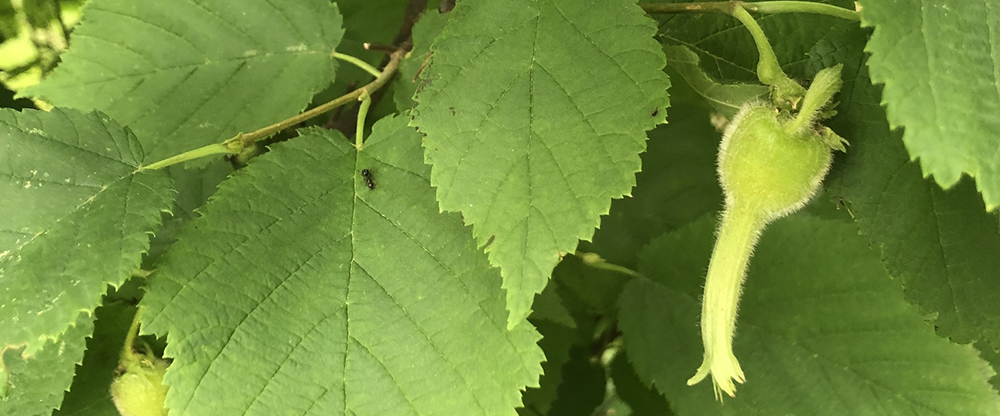
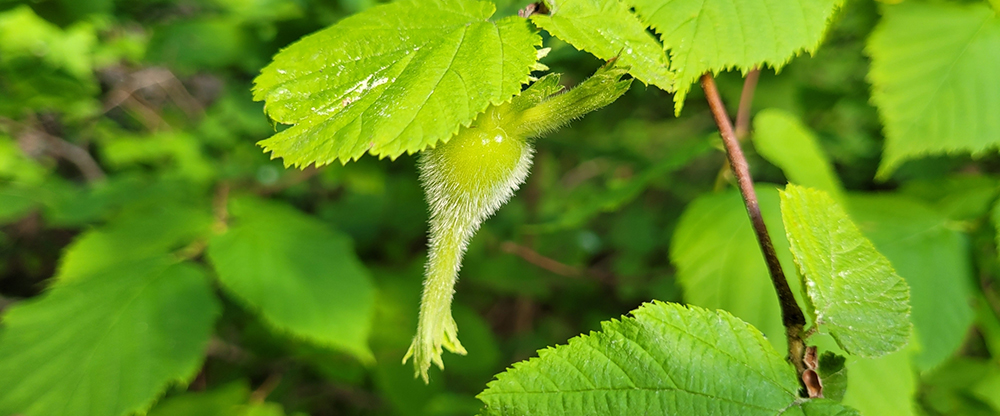
Uses and Related Information
- Nuts can be eaten raw, as well as lightly roasted in the same ways as a hazelnut
- Nuts can be ground down into a meal
- With a large nut harvest, oils can be expressed and added to various dishes for a nutty flavour
- Tea made from the bark is said to help treat colds and fever, and used as a wash for hives
Shrubs
Cranberry (Vaccinium oxycoccos and macrocarpon)
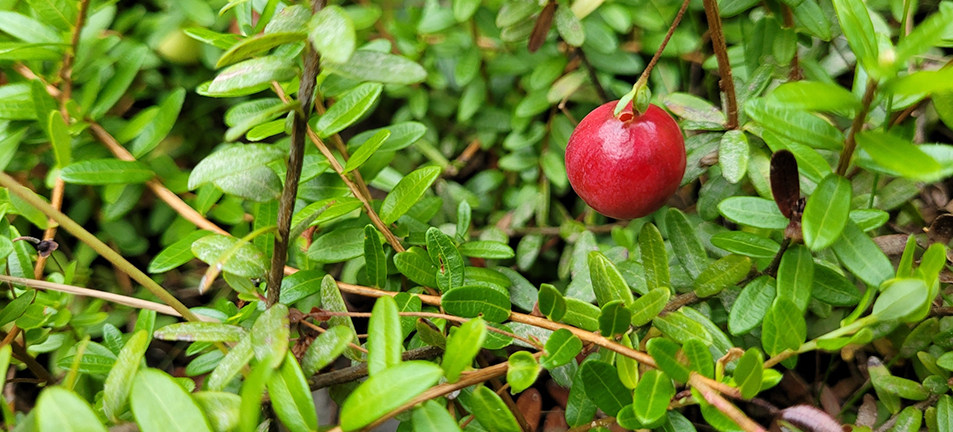
Identification
- Mostly under 20 cm in height
- Flowers pink, berries red/purple
Location
- Wet areas and near bogs, ponds and lakes
Harvesting Time
- September to November (best after first frost)
Uses and Related Information
- Berries can be eaten raw or processed into jams or jellies, juices, sauces or teas
- Berries can also be added to both sweet or savoury foods, such as pies, muffins, soups, stews or salads
- The health benefits of cranberries are said to include reduced risk of the formation of kidney stones, and relief from bladder infections, cramps and nausea
- Tannins in the cranberries are said to improve heart health and reduce both tooth decay and the formation of plaque on teeth
Cautions
- Consume only in moderation to avoid possible irritation of stomach
American Red Raspberry (Rubus idaeus var. strigosus)
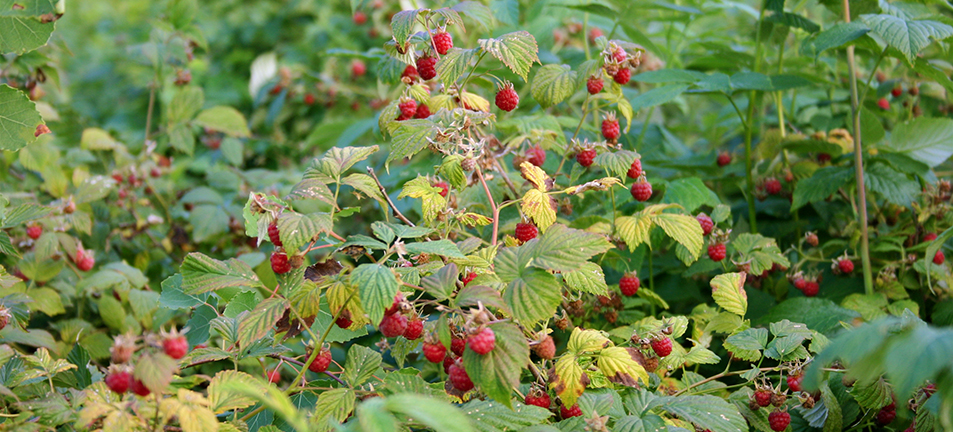
Identification
- Up to 2 m in height
- Prickly spreading stems, becoming smoother with age
- Alternate compound leaves on prickly stalks, usually three to five leaflets per leaf
- Flowers white/green
Location
- Can grow in a wide variety of habitats
- Tends to grow spaced apart in shaded areas and more densely in open fields
Harvesting Time
- Summer
Uses and Related Information
- Berries can be eaten raw, made into jams, jellies, or juices or added to desserts
- Young, peeled stems are edible in both raw or cooked preparations
- Some people boil the leaves into a tea to treat diarrhea and cramps
Cautions
- Do not consume wilted leaves, which can be toxic

Northern Bush-Honeysuckle (Diervilla lonicera)
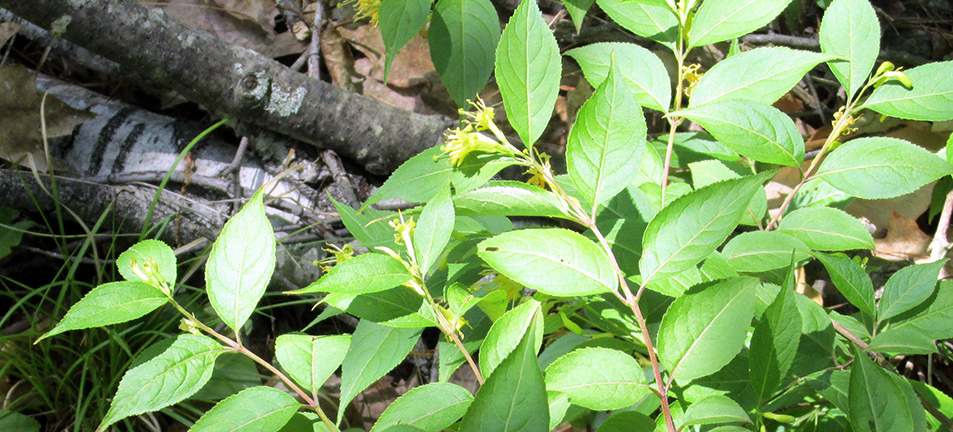
Identification
- 1 m or less in height
- Leaves usually oval but pointed at end (edges tend to curl inwards)
- Flowers yellow for most of the season, turning orange by late summer
Location
- Sunny to moderately shady wet or dry areas, edge habitat
Harvesting Time
- June to July
Uses and Related Information
- Infusions made from the bark and stems are said to flush toxins from the body and improve kidney health
- This plant was used in traditional Indigenous medicine, though this use is not common today
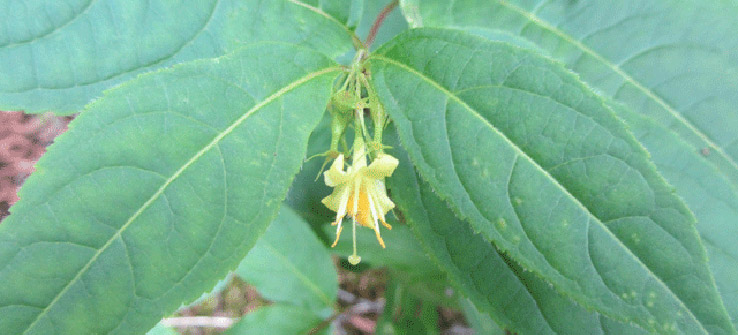
Prickly Rose (Rosa acicularis)
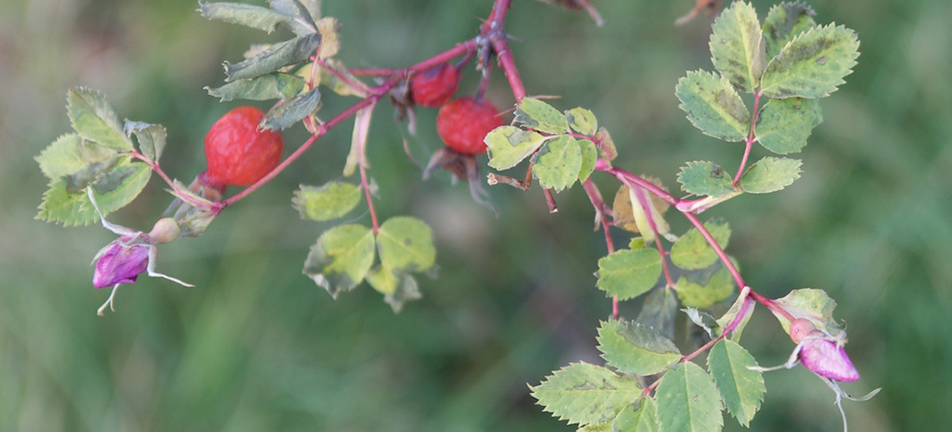
Identification
- Up to 1.5 m in height with prickly stems and branches
- Red hips (fruit) usually 1 or 2 cm in length, flowers pink
Location
- Open woods, thickets, rocky slopes
Harvesting Time
- Spring to winter
Uses and Related Information
- Raw petals can be added to salads, teas and jellies are said to soothe headaches, mouth sores and indigestion
- Buds, young shoots and leaves can be eaten raw or sautéed with other vegetables
- Rosehips are high in vitamins and nutrients and can be dried or boiled in teas, or preserved in jams or jellies (though this can be very time-consuming due to their small size and the large number required to make a medium sized batch of jam)
- Three rosehips are said to contain the same amount of vitamin C as one orange
Cautions
- Use only whole rosehips or their fleshy outside layer, as the seeds can cause intestinal discomfort
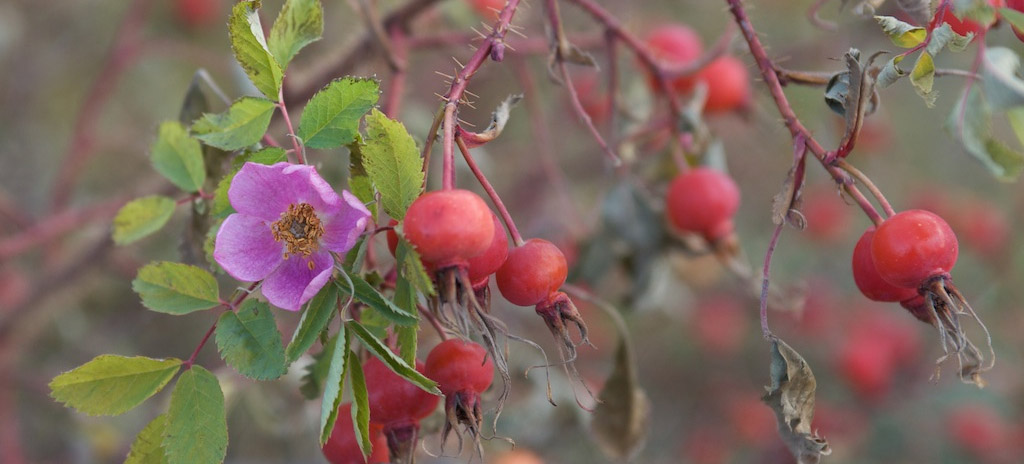
Willow (Salix spp.)
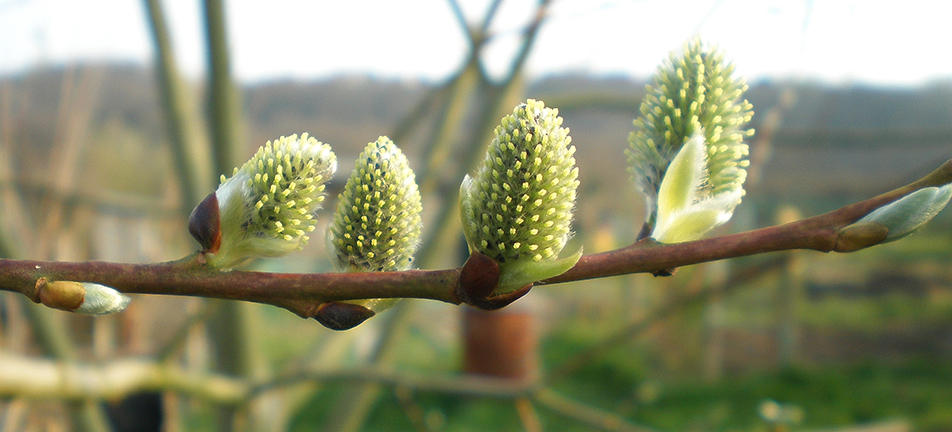
Identification
- 0.5 to 10+ m in height, depending on species
- Four buds completely encircling the stem
- Flower shape, size and colour variable, depending on species
Location
- Variable depending on species, but usually near moist areas or near water
Harvesting Time
- Spring to summer (bark and catkins best in spring, leaves best in summer)
Uses and Related Information
- Shoots are watery in taste and texture, and can be used similarly to cucumber
- Catkins can be cooked with other vegetables or added to soups for a boost of vitamin C
- Bark contains salicin (similar to Aspirin or acetylsalicylic acid) and can be chewed or made into a tea that is said to relieve pain, inflammation and digestive problems
- Leaves and twigs can be boiled to make a rinse that is said to increase the shininess of hair and reduce dandruff
Cautions
- Do not consume willow if you have a known sensitivity to Aspirin
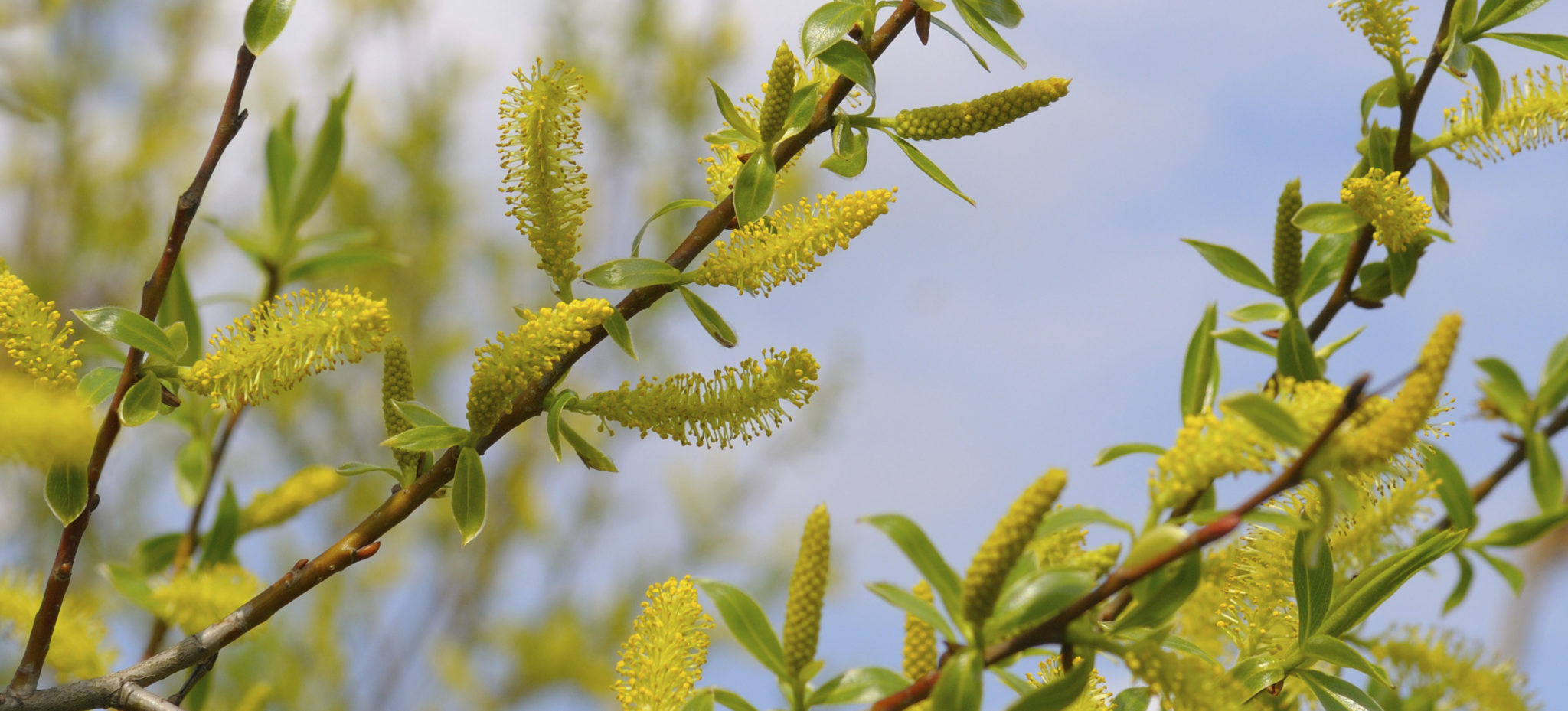
Saskatoon Berry (Amelanchier spp.)

Identification
- Grows as a straggling small shrub, occasionally up to 5 m tall
- Leaves are alternately arranged with an oval or elliptical shape
- Amelanchier species may be difficult to tell apart, but the berries from each species are edible
Location
- Variety of habitats, ranging from dry to moist areas
Harvesting Time
- July and August
Uses and Related Information
- Berries are excellent when eaten fresh or cooked
- Fruit can be dried for later use
- Can be ground up with tallow and dried meat to make pemmican
- Berries are high in iron and copper
- Stems and roots of the plant boiled into a tea are said to treat lung issues associated with tuberculosis, colds and fevers
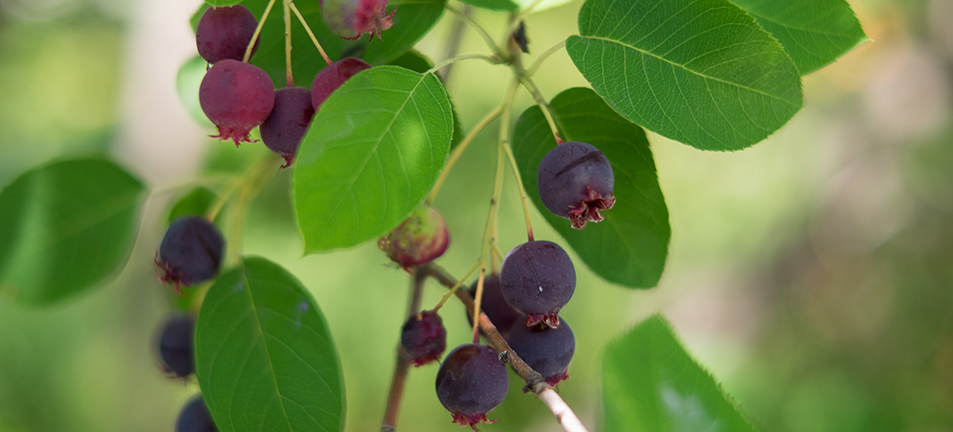
Herbaceous Plants
Bluebead Lily (Clintonia borealis)
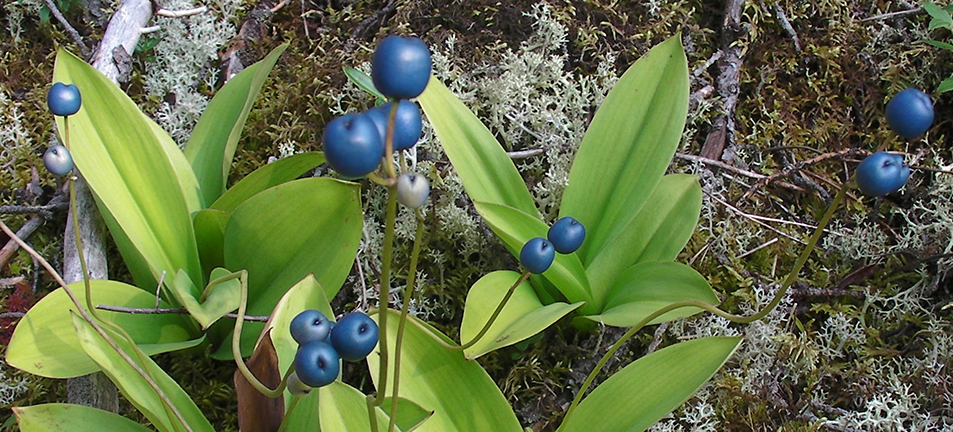
Identification
- Up to 40 cm in height
- Large leaves with parallel veins and smooth margins
- Yellow-green flowers and blue berries on long stalks
Location
- Forests with open understorey
Harvesting Time
- Spring
Uses and Related Information
- Leaves can be eaten raw or cooked and taste similar to cucumber
- A poultice made from the leaves can be used on wounds and bruises and is said to prevent infection and promote healing
Cautions
- Do not eat the berries, which are toxic
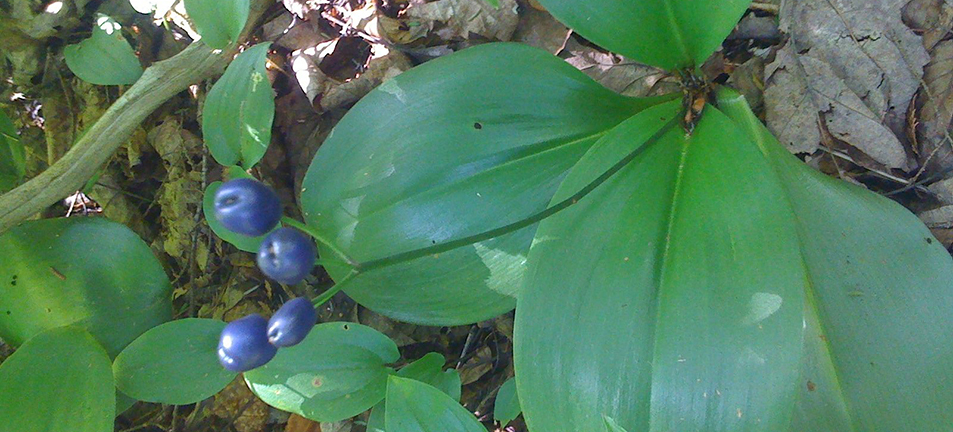
Burdock (Arctium spp.)
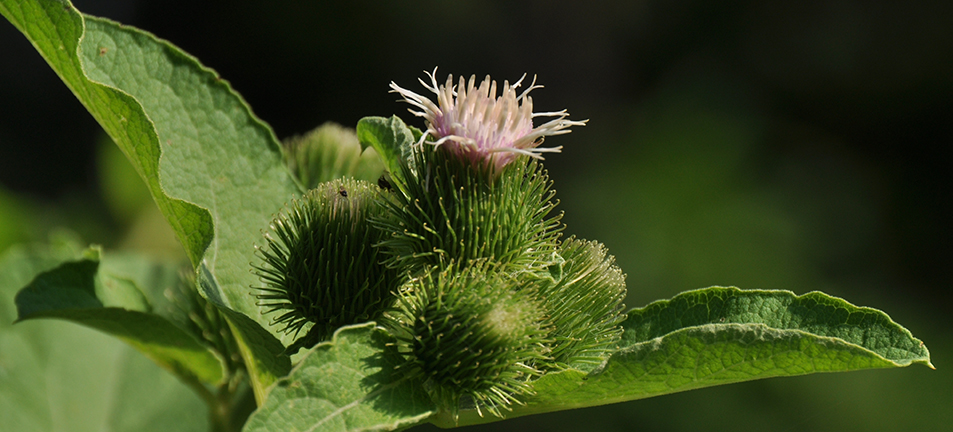
Identification
- 0.5 to 1.5 m in height (on average, will vary by species)
- Pink/purple flowers with large burrs
- Heart-shaped hairy green leaves with soft white undersides
Location
- Roadsides, disturbed areas
Harvesting Time
- August to October
Uses and Related Information
- Young leaves (picked in spring or early summer) can be added raw to salads, cooked in soups and stews, or boiled (one or two changes of water may be needed to reduce the bitter quality of the leaves)
- Peeled roots can be boiled, stir-fried or pickled
- Medicinal teas made from the leaves are thought to help purify the blood and improve liver and kidney function
Cautions
- Do not consume if you are pregnant (can cause spotting or miscarriage) or diabetic (can affect blood sugar levels)
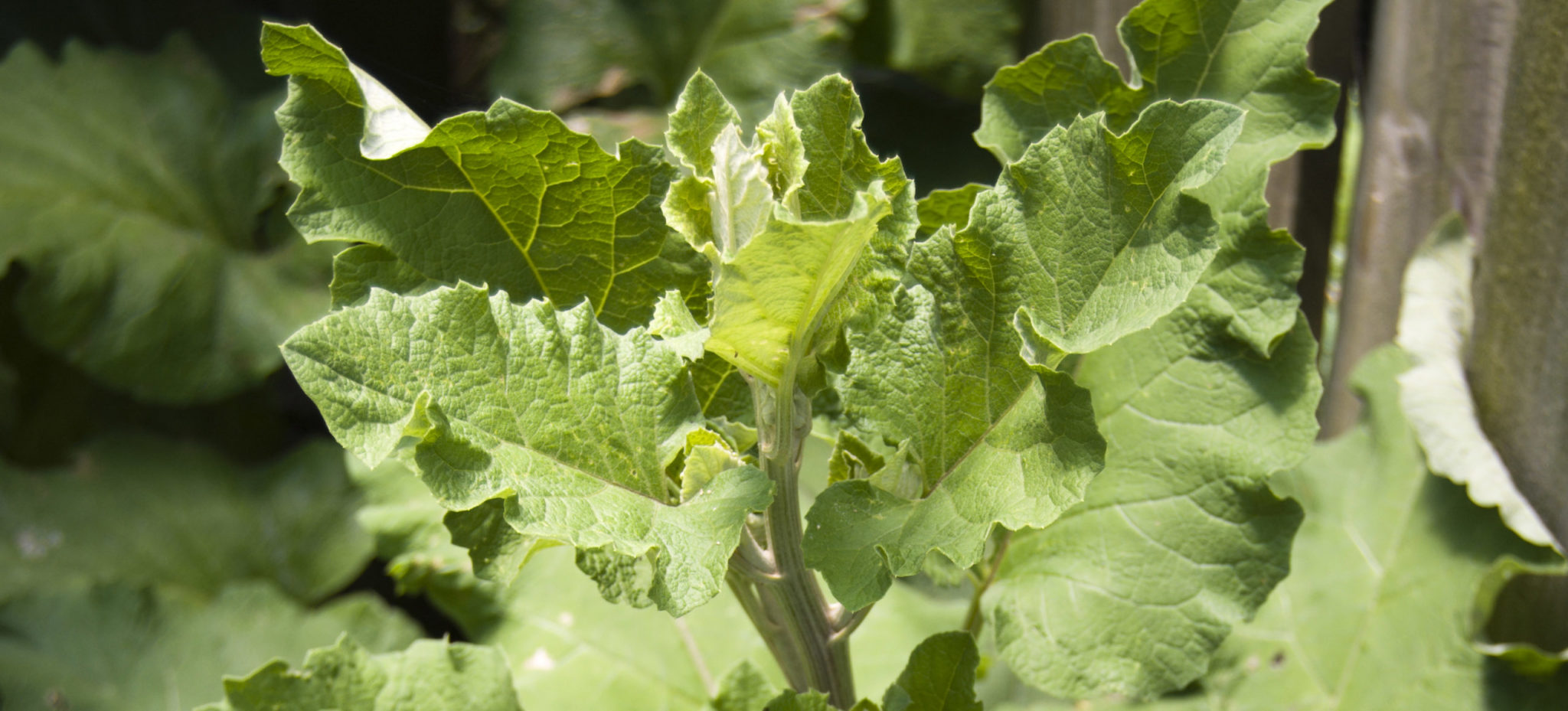
Cattail (Typha spp.)
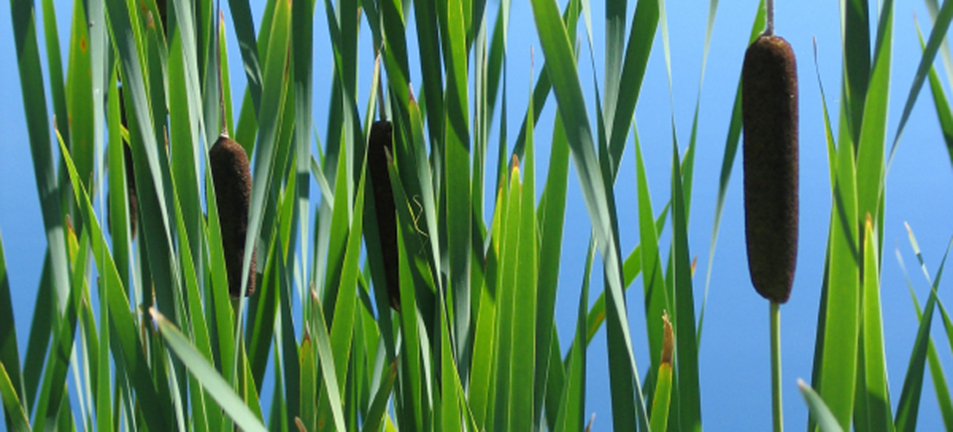
Identification
- 1 to 3 m in height
- Leaves long, slender and stiff
- Flowers forming tight cylindrical clusters
Location
- Marshes, lakes and streams with calm waters
Harvesting Time
- Spring for flowers and pollen, fall to early spring for roots and shoots
Uses and Related Information
- The core of tastes similar to cucumber and can be eaten raw, boiled sautéed or fried
- When green, flower heads can be steamed or roasted once the stalk and papery outer layer are removed
- The pollen can be collected by shaking the flower head into a bag then sifting the contents to separate the pollen, and can be used in both savoury and sweet recipes
Cautions
- Ensure that you have correctly identified this plant before eating it, because young cattails may be mistaken for some members of the Iris family, which are poisonous.
- Avoid cattails growing in stagnant water area due to their unappealing taste and uptake of contaminants.
- Do not eat brown flower heads

Common Dandelion (Taraxacum officinale)

Identification
- 5 to 45 cm in height, with a long taproot
- Rubbery stem containing a milky white liquid
- Bright yellow flower at the end of the stalk
Location
- Disturbed areas, roadsides, lawns and gardens, meadows
Harvesting Time
- May to August (stems and leaves increasingly bitter later in the season)
Uses and Related Information
- Leaves can be eaten fresh in salads, cooked in soups and stews, or dried and used to make tea (young leaves are preferable as older leaves become bitter)
- When roasted in the oven for several hours, the roots develop a coffee/cocoa-like flavour and when ground are good for making tea or using in baking
- Stems can be boiled and used as a substitute for pasta
- Flowers can be added to salads
- Dandelion is thought to reduce blood pressure, blood sugar and cholesterol
- The leaves of dandelions grown in shady areas are less bitter than the leaves of plants grown in sunny areas
- Drying or freezing of dandelion leaves best preserves them for later use
Cautions
- Avoid eating dandelions from lawns or urban landscapes on which pesticides and pollutants may have been deposited
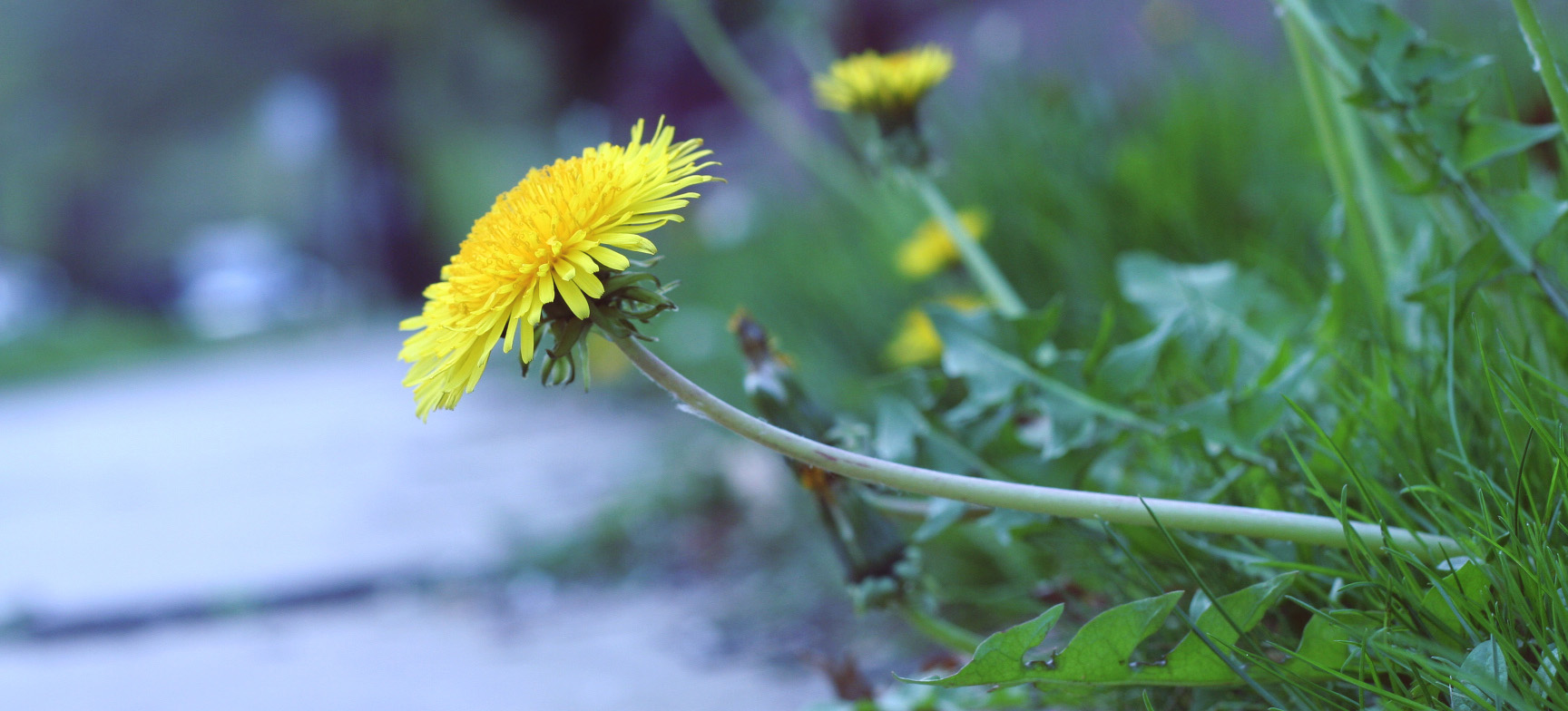
Common Evening Primrose (Oenothera biennis)
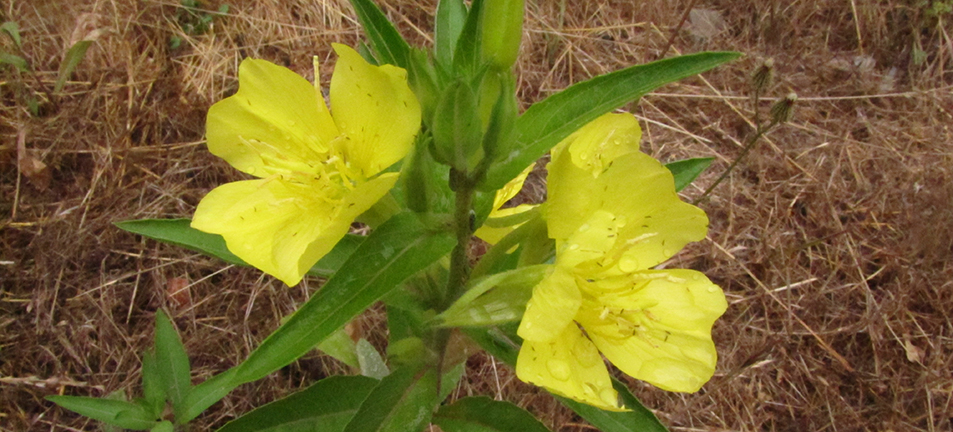
Identification
- 0.5 to 1.5 m in height with a hairy stem
- Leaves slightly toothed at margins and attached directly to the stem
- Leafy spike of large yellow flowers at the top of the plant
Location
- Moderately dry, open sites, roadsides
Harvesting Time
- June to August
Uses and Related Information
- Roots, which are similar in taste and texture to parsnips, can be eaten raw or boiled for two hours (changing the water several times lessens the peppery flavour)
- Cooked roots can be fried, pickled, roasted and served as a side dish, added to soups or stews and candied in syrup
- Young leaves, flower buds and green pods can all be boiled like leafy greens (changing the water several times)
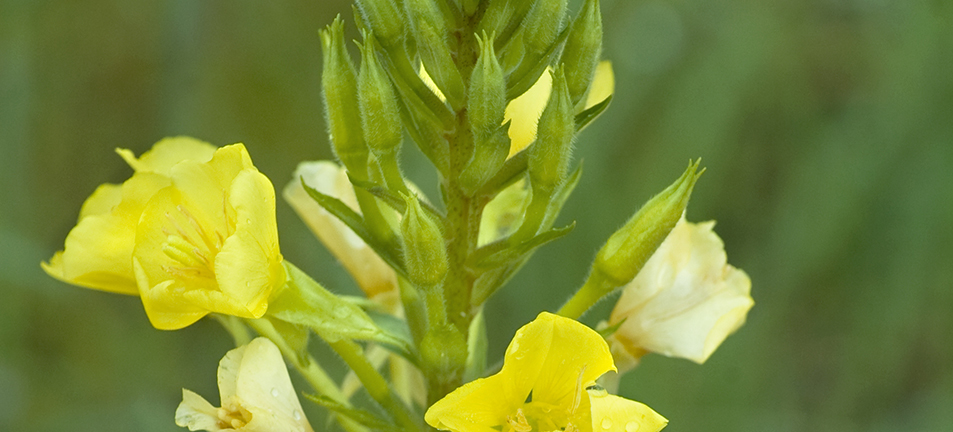
Common Mullein (Verbascum thapsus)
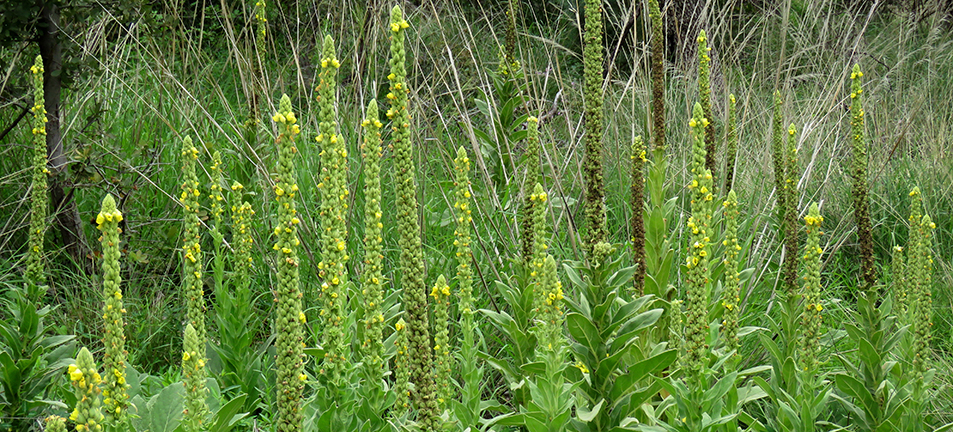
Identification
- First year of growth produces soft woolly leaves similar to lamb’s ears
- Second year of growth produces a flowering stalk up to 1.8 m in height with yellow flowers
Location
- Dry, sunny disturbed areas such as roadsides, open fields and areas near railways
Harvesting Time
- July to September
Uses and Related Information
- Leaves and flowers can be used in salads or teas, though teas must be strained to remove seeds
- Teas made with flowers and leaves are said to be useful in treating colds and diarrhea, while teas made with the stalks are said to be useful in treating cramps and fevers
- Some people use the leaves in a poultice to treat ulcers and hemorrhoids
- Mullein contains a variety of vitamins and nutrients essential for healthy growth and development
- Campers know this plant as “cowboy’s toilet paper”, but when used as such it may irritate sensitive skin
Cautions
- Before consuming tea made from mullein, strain out the seeds, as the seed hairs may irritate the throat
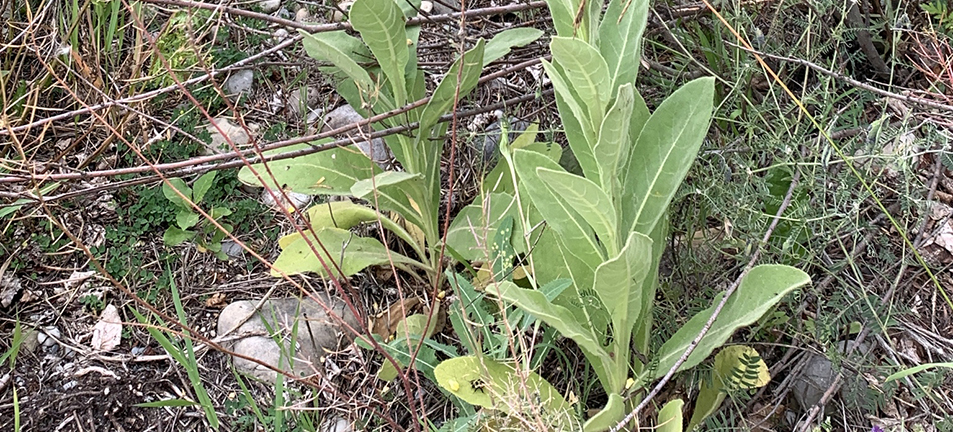
Common Plantain (Plantago major)

Identification
- Up to 15 cm in height
- Leaves egg-shaped with wavy margins and almost parallel veins
Location
- Disturbed areas, clearings, roadsides, edge habitats
Harvesting Time
- Summer to early fall
Uses and Related Information
- Leaves can be eaten raw or in salads, steamed or sautéed, or tossed in oil and cooked in the oven (prepared like kale chips)
- Some people use the leaves in a poultice to treat insect bites and stings
- Some people make tea from the leaves which is said to soothe toothaches, coughs, sore throats and breathing problems
- To preserve the taste, texture and nutritional properties of the leaves, plantain should be stored in a dark place
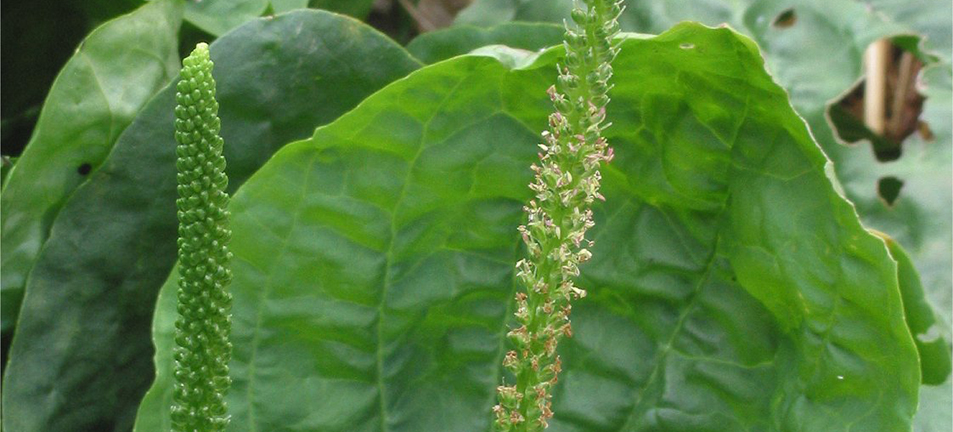
Common Yarrow (Achillea millefolium)
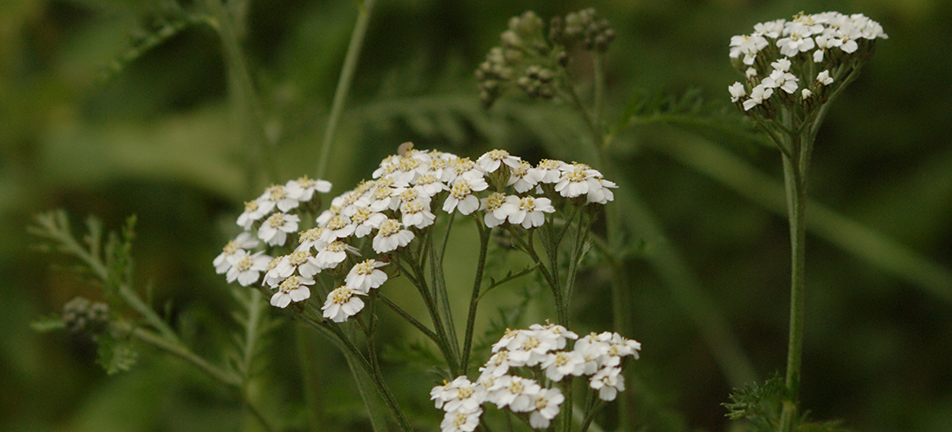
Identification
- 10 to 80 cm in height
- Leaves long and slender, similar in appearance to a fern
- Flowers yellow, white or pink, forming in flat clusters
Location
- Meadows, disturbed areas, roadsides, waste areas
Harvesting Time
- June to September
Uses and Related Information
- Leaves can be eaten raw or cooked, but young leaves are best in raw preparations like salad
- Tea made from boiling the flowers is said to be useful in treating sore throats, colds and fevers
- Some people use the leaves as a poultice to stop bleeding, as well as a natural band aid due to the plant’s antibacterial properties
- Hang the plant to dry at room temperature, away from direct sunlight
Cautions
- Do not consume this plant if you are pregnant
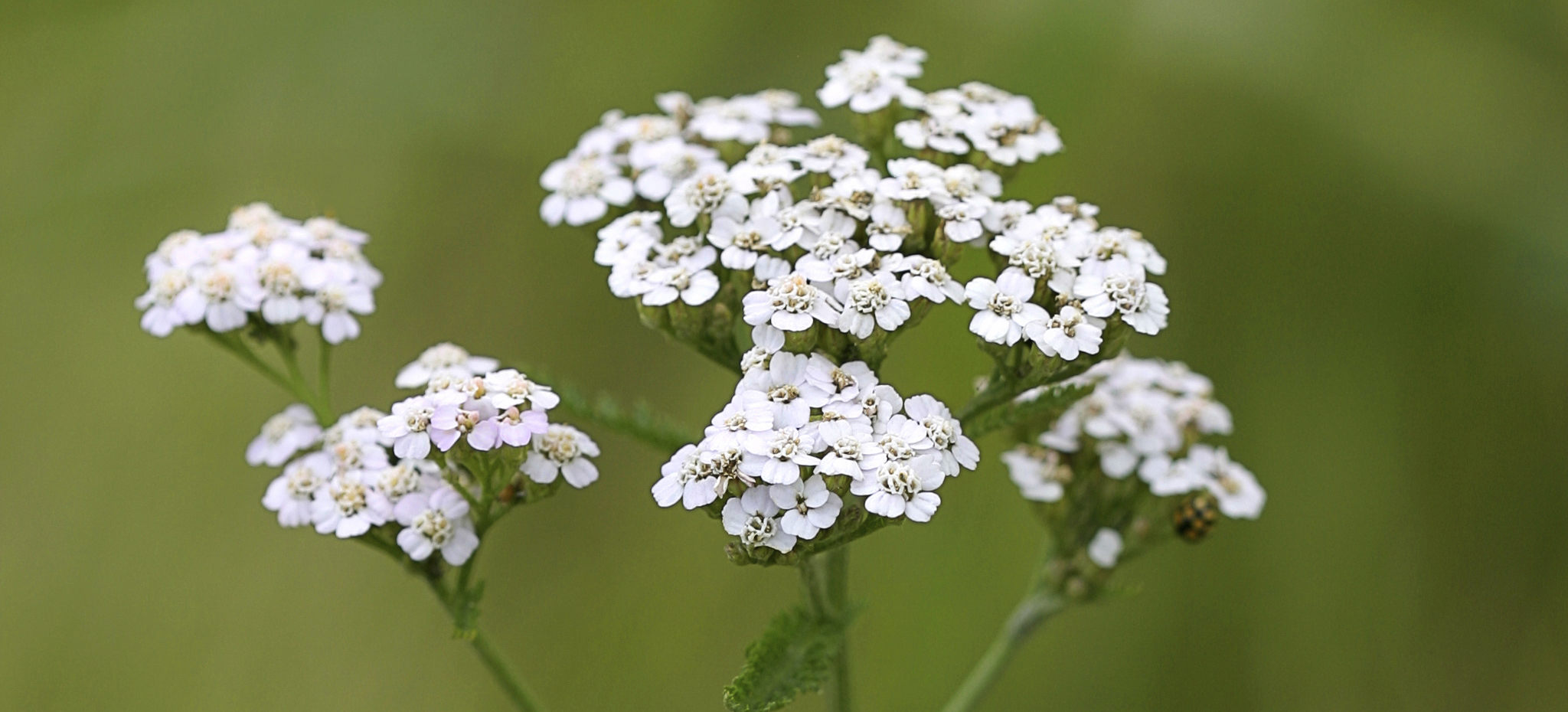
Field Horsetail (Equisetum arvense)
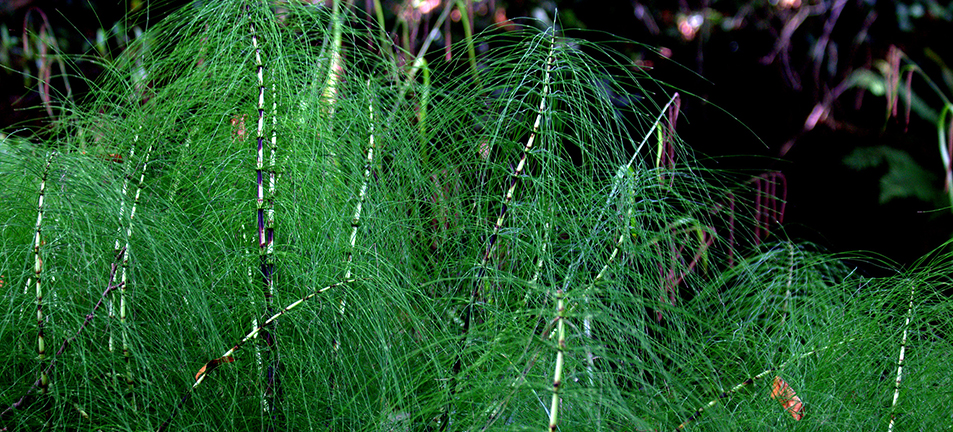
Identification
- Two forms of growth: in spring, stiff branchless stem (10 to 20 cm in height); from summer to early fall, flexible, green, feather-like plant (10 to 80 cm in height)
- Usually growing in large clusters
Location
- Clearings, open areas, in conifer and mixed-wood forests, roadsides, and disturbed areas
Harvesting Time
- Early summer
Uses and Related Information
- Some people use the leaves and shoots to prepare tea which is said to be useful in treating kidney stones and inflammation; this tea can also be used as a hair rise for shinier hair
- Shoots, which contain essential nutrients, can be cooked thoroughly with other vegetables
- The whole plant can be used as a steel wool substitute when camping because of the high levels of silica in them stem and leaves
- Outer layers are tough and fibrous and should be removed before use
- Because horsetail contains high levels of silica, it is said to strengthen hair, nails and bones when consumed
Cautions
- Do not consume horsetail growing in contaminated soil, because these plants can absorb toxins from it
- Because horsetail contains silica, the kidneys cannot process large amounts of it, consume only small amounts of this plant
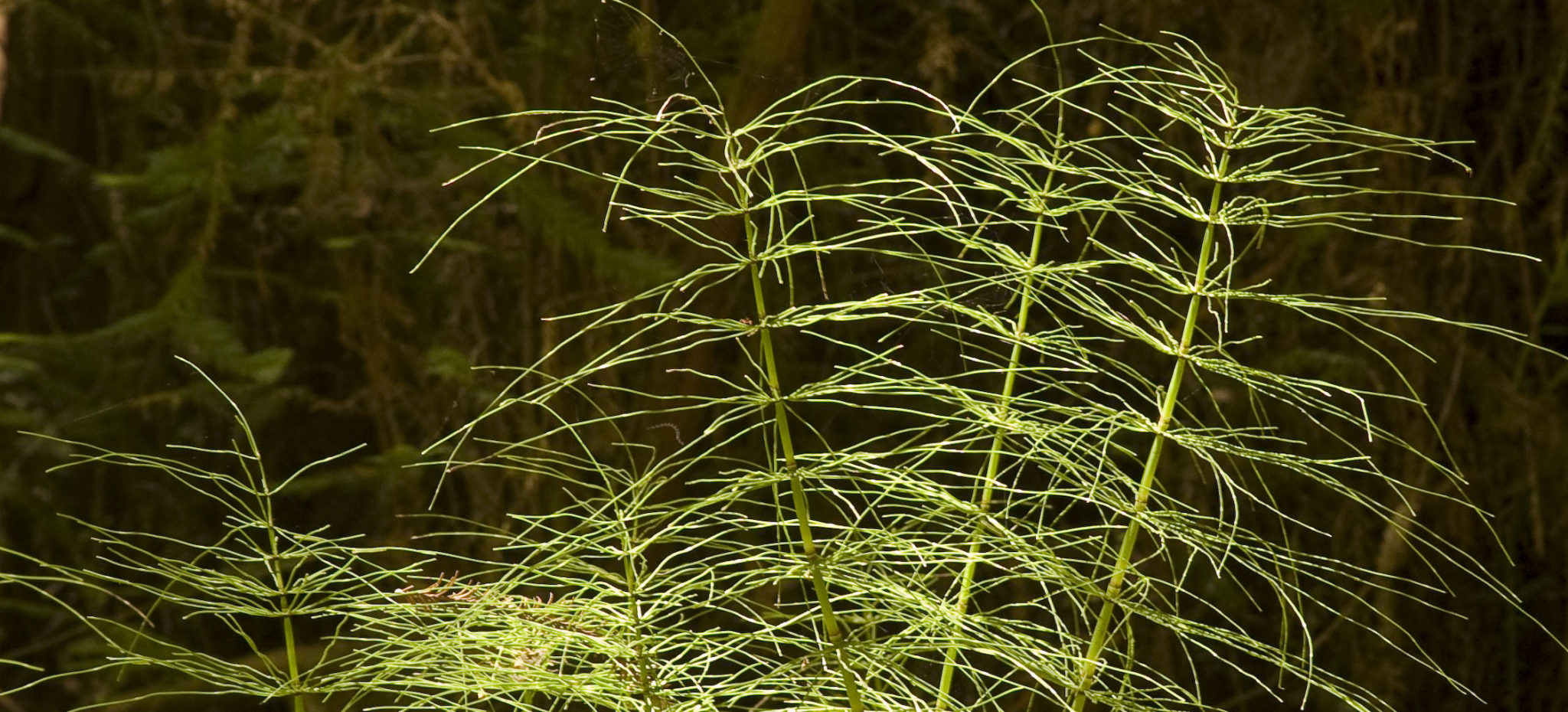
Goldenrod (Solidago spp.)
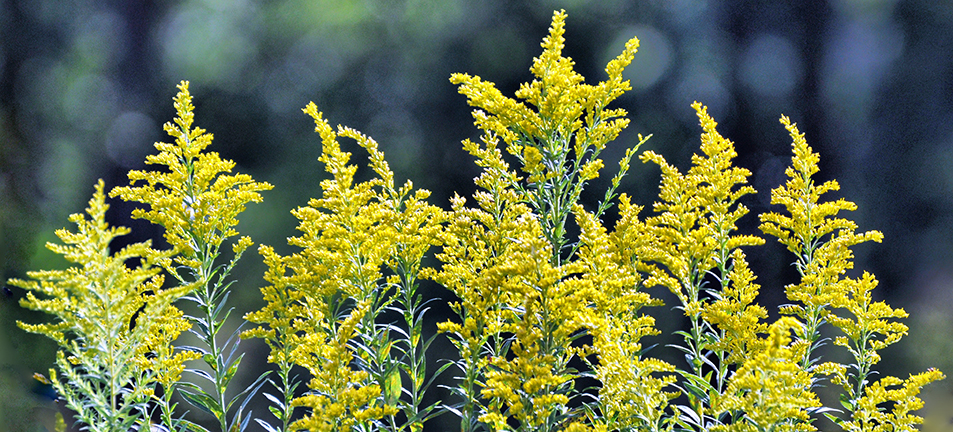
Identification
- 30 to 150 cm in height, depending on species
- Long slender leaves with sharply toothed margins
- Long clusters of yellow flowers at the top of the plant
Location
- Moist areas, forests, fields, roadsides, disturbed areas
Harvesting Time
- July to September for flowers and leaves, fall or early spring for roots
Uses and Related Information
- Flowers can be added to salads, and leaves can be cooked like spinach or added to soups, stews or casseroles
- Some people boil the flowers and leaves to make a tea which is said to be useful in treating cold or flu symptoms, gas, cramps and headaches
- Blanched leaves can be frozen and used at a later date
- When eaten raw or cooked, goldenrod has a licorice-like flavour
- Roots contain inulin, which is said to promote healthy stomach bacteria
Note
Many people believe they are allergic to insect-pollinated goldenrod, but usually it is ragweed (which is wind-pollinated) that causes their symptoms.
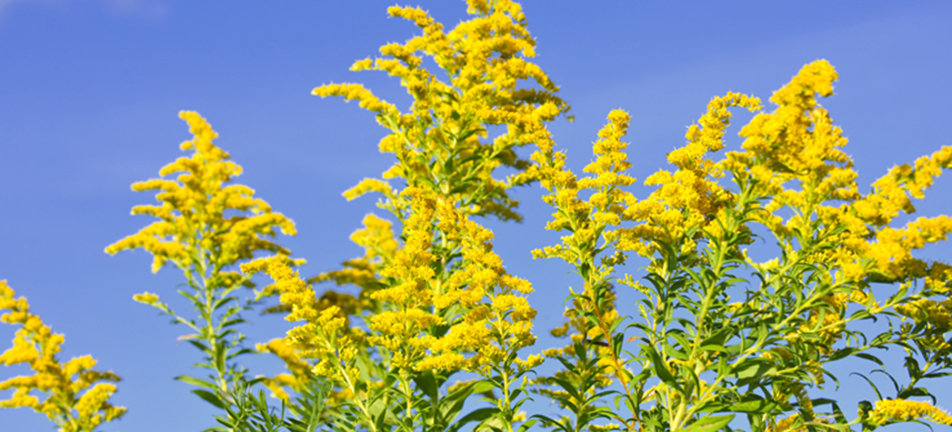
Lamb’s Quarters – White Goosefoot (Chenopodium album)
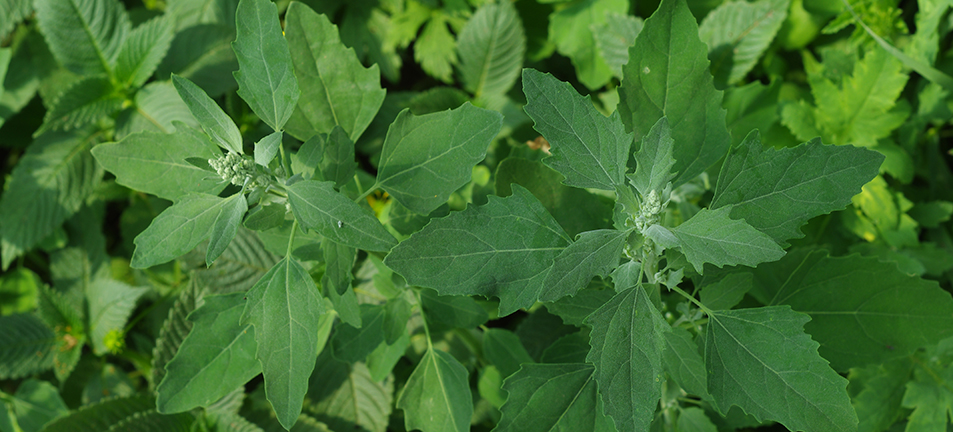
Identification
- Stems 30 cm to 1 m in height
- Leaves variable in shape, with a white coating on the underside
- Flowers forming long green clusters
Location
- Gardens, disturbed areas, areas near agricultural activity
Harvesting Time
- Summer
Uses and Related Information
- Fresh young leaves are best and can be eaten raw or in salads or added to smoothies and soups or other cooked preparations
- Leaves are similar in taste and preparation to spinach, with four times as much calcium and 50% more protein – six cups of raw leaves cook down to about a 1/2 cup
- The plant produces small seeds in the late summer or fall, similar in appearance to quinoa (as the plants are relatives), which can be sprinkled on salads
Cautions
- Because it contains some oxalic acid, consume only small amounts of this plant
- Do not consume large amounts of seeds, due to the saponins they contain
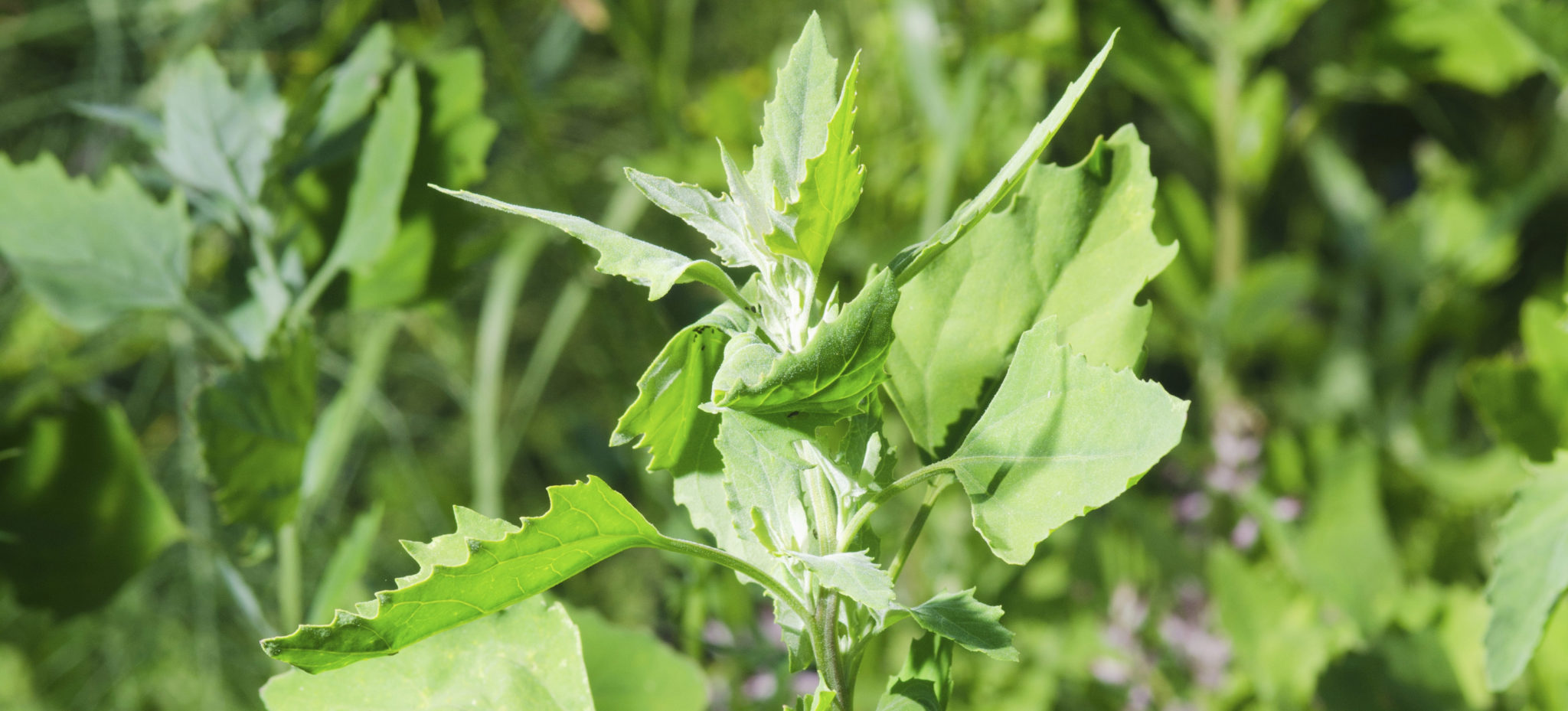
Ostrich Fern (Matteuccia struthiopteris)
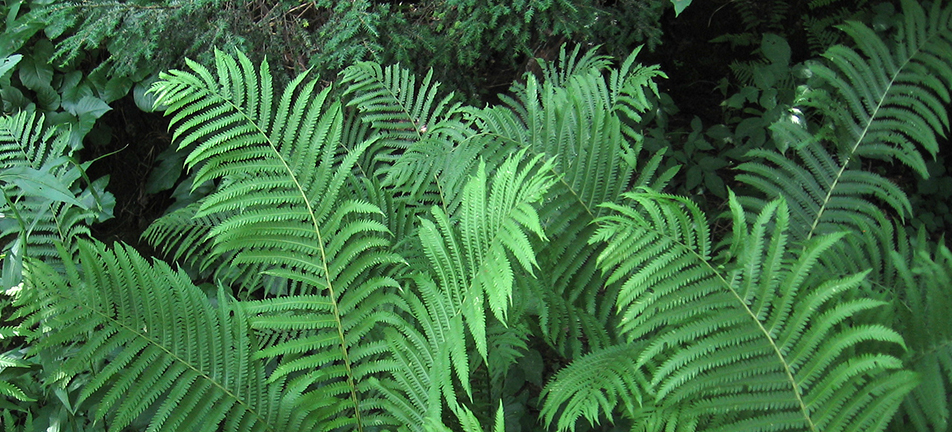
Identification
- Approximately 1 m in height
- Two forms of fronds: long feather-like green fronds and short brown fronds
- Bright green emerging fronds (fiddleheads) tightly coiled with a scaly brown paper-like covering and a U-shaped groove in celery like stem
Location
- Moist areas, near water (streams, lakes), swamp edges, some open forests
Harvesting Time
- Mid-spring
Uses and Related Information
- A popular way to prepare fiddleheads is to boil them and then fry or sauteé with butter and seasoning
- Cooked fiddleheads can be added to salads or soups and taste similar to asparagus
- Fiddleheads should be collected when less than 15 cm in height and still tightly curled
- They keep in the fridge for about two weeks or can be stored either dried or frozen (clean and blanch before freezing)
Cautions
- Consume only cooked ostrich ferns, because raw preparations may cause stomach irritation
- To ensure the plants survival take no more than half the fiddleheads on it
- As other species of ferns may be toxic if consumed, ensure you correctly identify ostrich ferns by consulting guides, images and experts
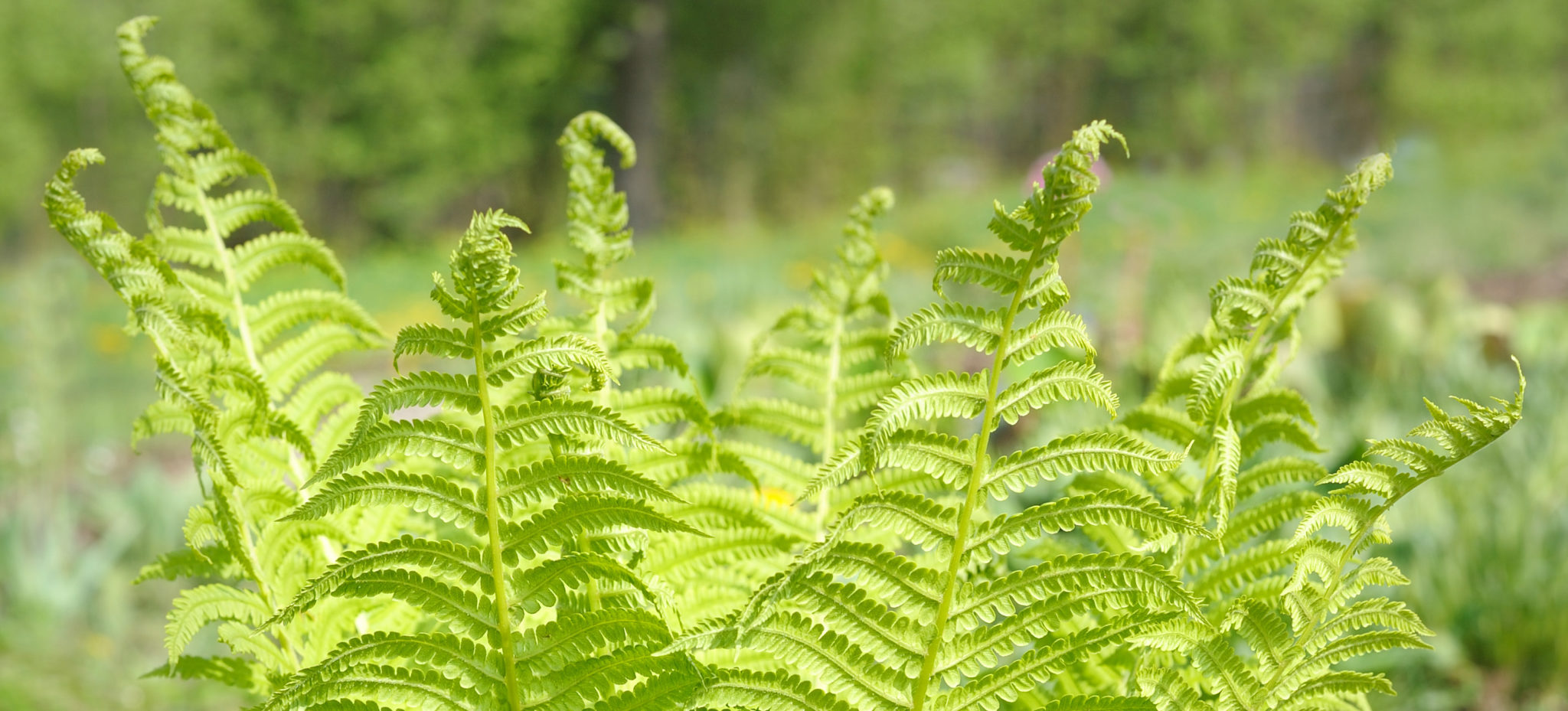
Pearly Everlasting (Anaphalis margaritacea)

Identification
- 10 to 90 cm in height, covered in smooth white hairs
- Leaves long, narrow and hairy on the undersides
- Flowers small and white with yellow eyes, usually clustered at the top of the plant
Location
- Sunny open areas, disturbed areas, edge habitat
Harvesting Time
- July to September
Uses and Related Information
- Some people use the leaves as a tea which is said to relieve sore throats, indigestion, nausea or diarrhea (younger leaves are more palatable than older leaves)
- A poultice made from the leaves is said to relieve joint pain or arthritis
- Indigenous peoples smoked the dried leaves of this plant both to relieve headaches and breathing problems, and also used the leaves in traditional smudging ceremonies to promote health and wellness
Cautions
- Use only the leaves in edible applications as they contain the beneficial nutritional and medicinal properties

Red Clover (Trifolium pratense)
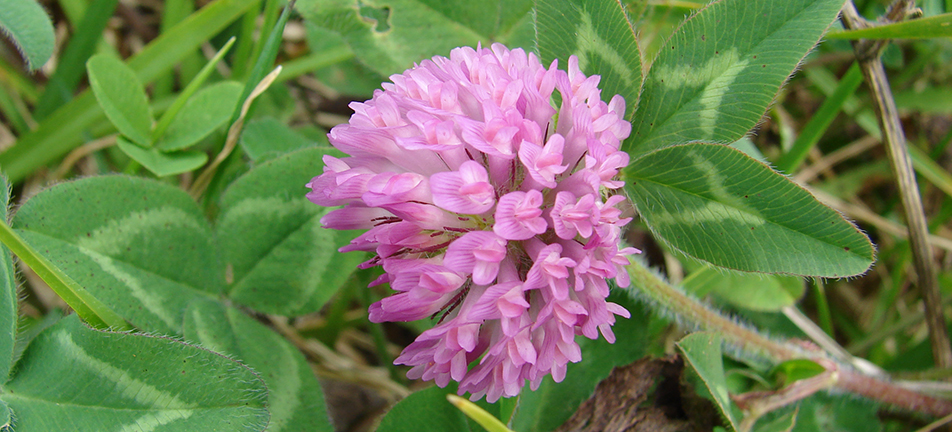
Identification
- 5 to 40 cm in height with hairy stems
- Classic clover leaf with three leaflets
- Light green V-shaped mark on each leaf
- Flower round and red/pink
Location
- Fields, pastures, roadsides, backyards
Harvesting Time
- Late spring to fall
Uses and Related Information
- Flowers can be eaten raw in salads, made into a detoxifying tea or lightly battered and deep-fried
- Clover is said to relieve premenstrual syndrome symptoms, such as cramping and hot flashes, and is thought to reduce bad cholesterol and plaque that causes heart disease
- The flowers can be dried and stored for later use
Cautions
- Consume the flowers and leaves in moderation, because they may cause bloating
- Do not consume clover if you are pregnant or nursing as it can affect the hormonal balance of the body
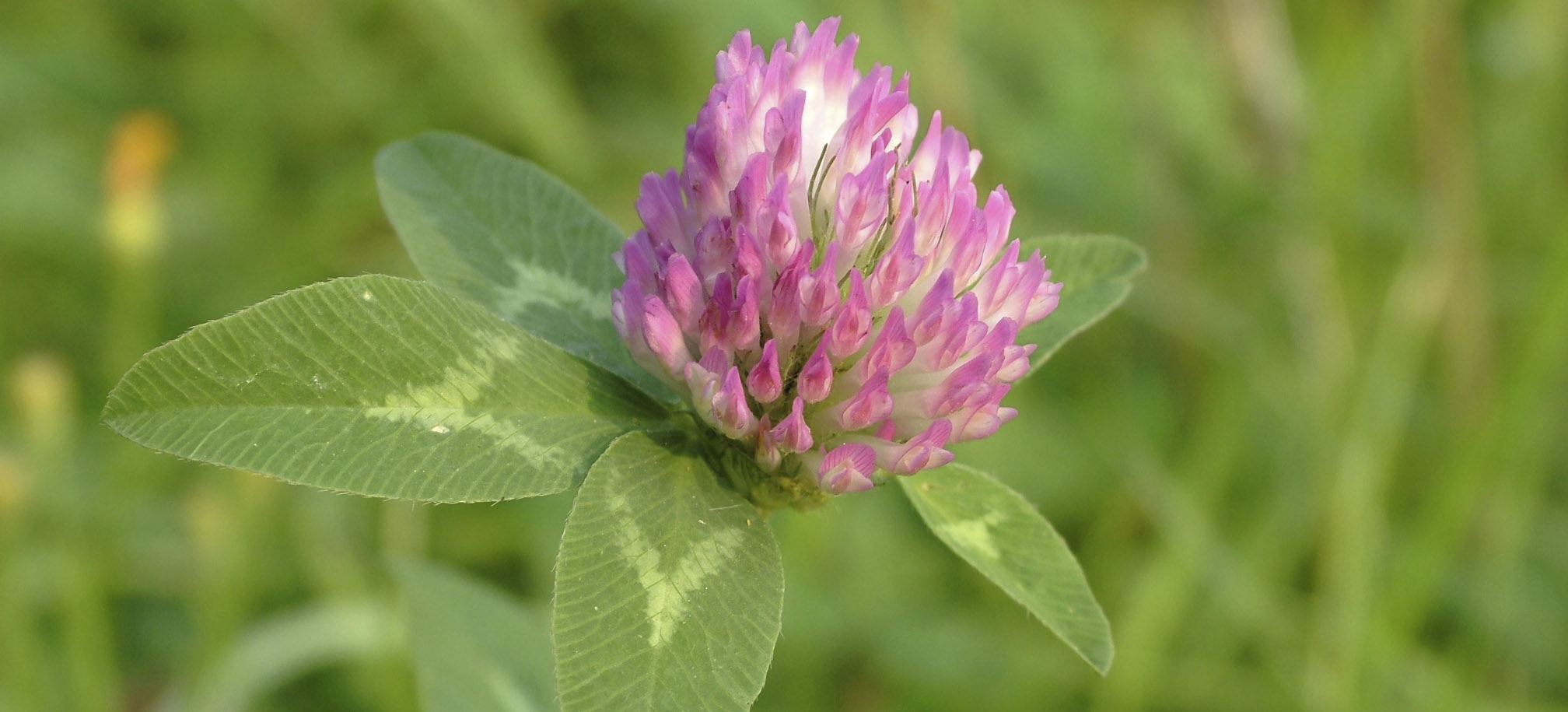
Stinging Nettle (Urtica dioica)
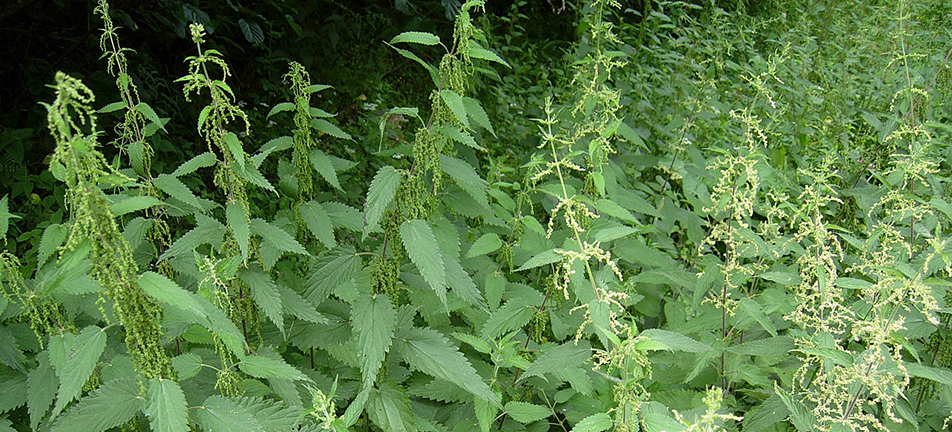
Identification
- Up to 3 m in height and covered in stiff “guard hairs”
- Flowers green, sometimes with a pinkish hue
Location
- Disturbed areas, hillsides, stream banks, moist woodlands
Harvesting Time
- Spring to early summer
Uses and Related Information
- Leaves are very similar to spinach and can be boiled as a side dish, sautéed with other vegetables or (like carrot or zucchini) chopped and added to muffins and breads
- Fibres from the stem can be made into twine for fishnets, snares and so on
- Boiling the leaves (as if making a tea) creates a rinse that improves the shininess of hair
- Cooking, crushing, drying and soaking the plant eliminates the stinging hairs, making the leaves safe to eat
- The health benefits of the plant are said to include relief from muscle and joint pain, as well as cleansing of the kidneys and liver
Cautions
- Wear thick gloves when harvesting this plant – the hairs on it can pierce through latex gloves and inject chemicals that cause skin to burn and itch
- Do not consume this plant if you are pregnant (stimulates the uterus and can cause miscarriage) or diabetic (affects blood sugar levels)
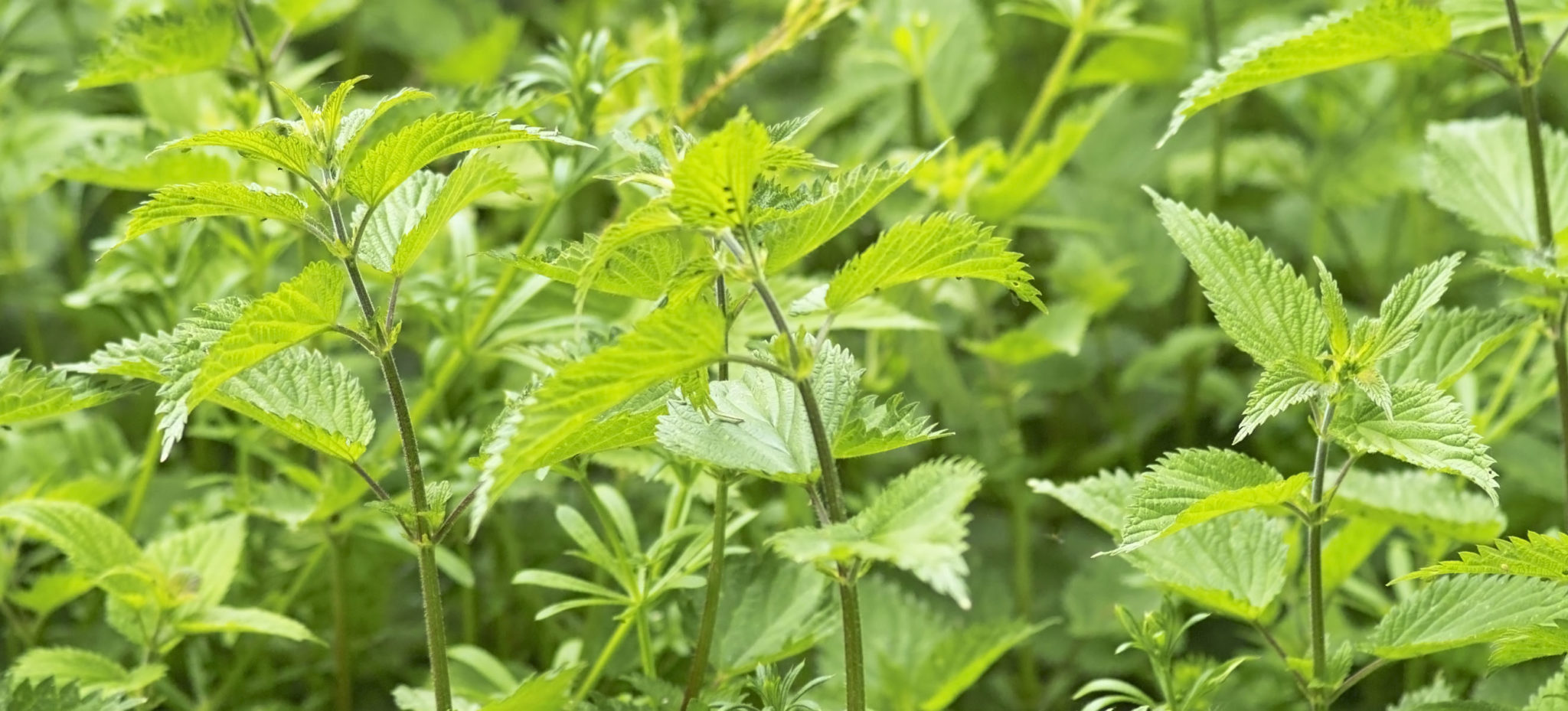
/Essentials Collection/Getty Images
Wild Mint (Mentha spp.)
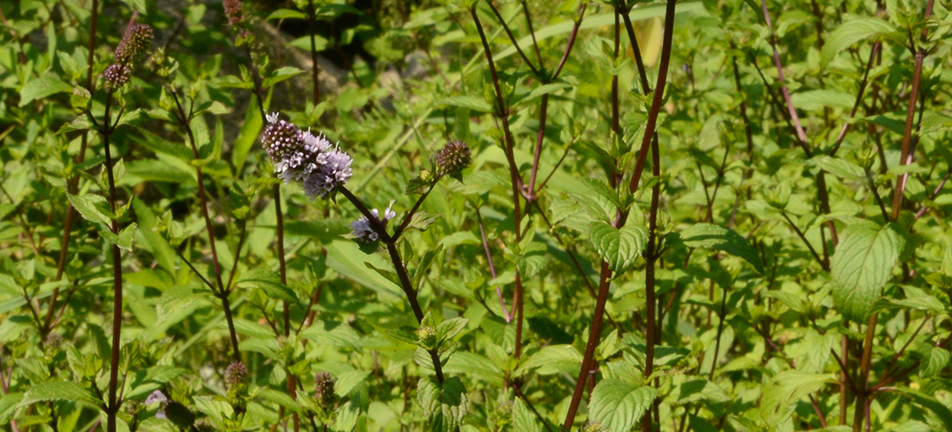
Identification
- 15 to 75 cm in height
- Square stem with opposite toothed leaves ending in sharp point
- Strong peppermint smell
Location
- Low-lying areas, near marshes or swamps, near beaver dams
Harvesting Time
- Spring to fall
Uses & Related Information
- Steeping a small handful of leaves and stems for 15 minutes creates a delicious tea that is said to be useful in treating menstrual cramps
- Dried, ground mint can be added to a variety of sweet and savoury dishes such as cakes, scones, pastas, pestos and so on
Cautions
- Do not use the plant if it is covered in white mold (typically in fall)
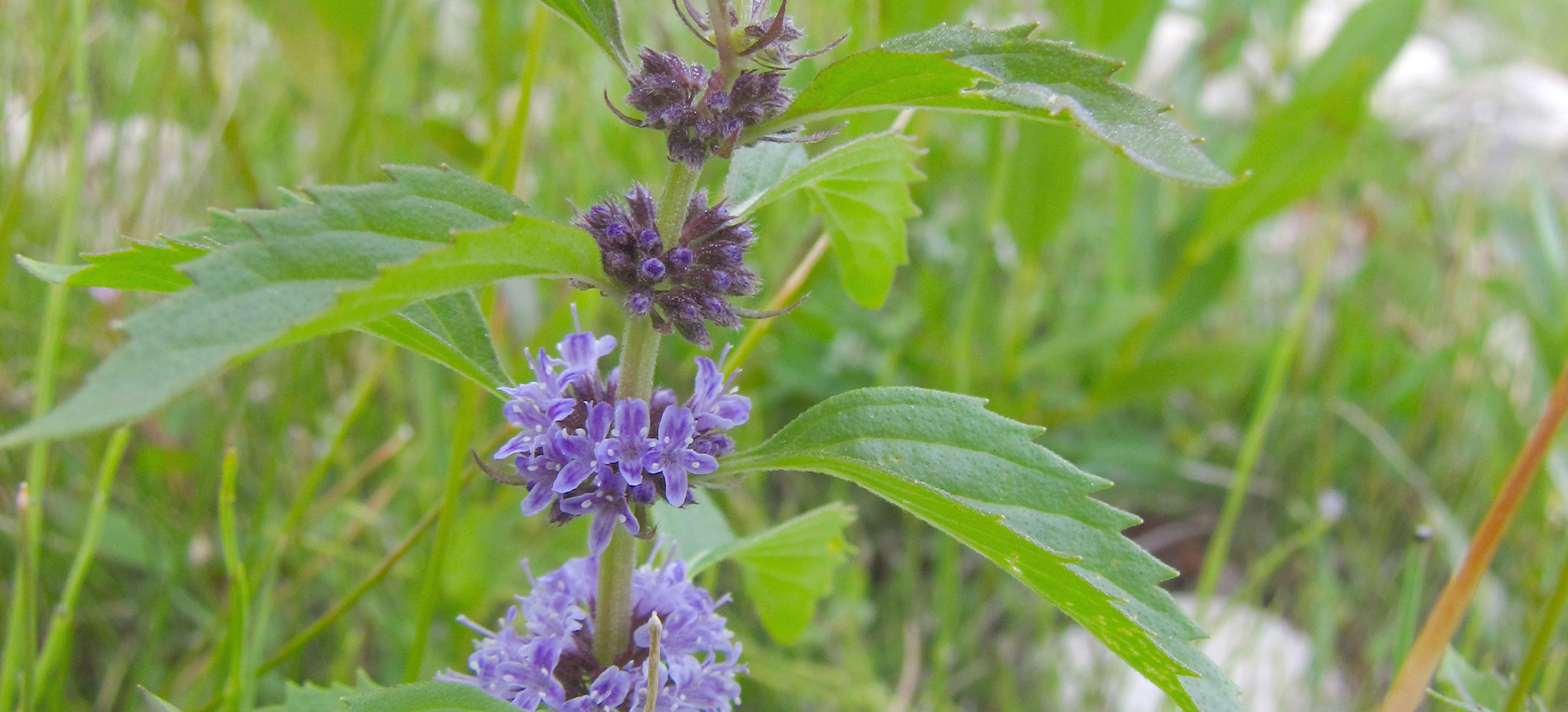
Wild Sarsaparilla (Aralia nudicaulis)
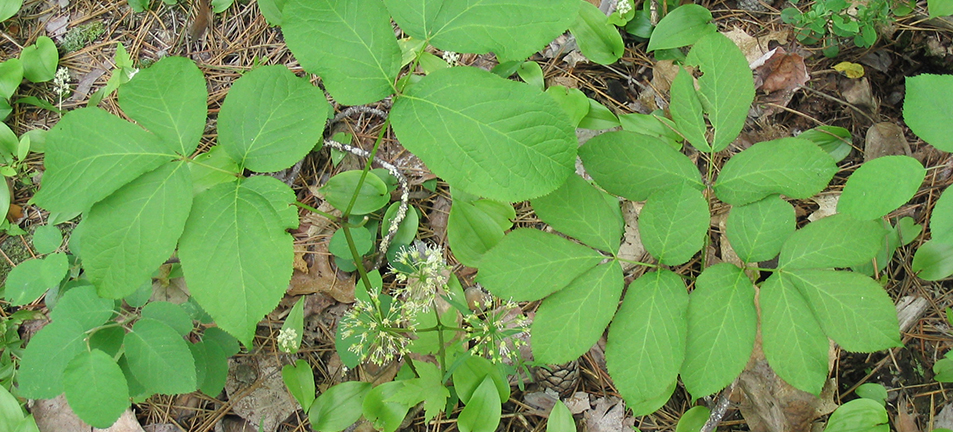
Identification
- Up to 50 cm in height
- Leaves pointed at the tip and compound, with three to five leaflets per leaf
- Flowers small and green or white
Location
- Moist areas, uplands, usually mature forest stands, often near oak trees
Harvesting Time
- Late summer through fall
Uses and Related Information
- Roots can be prepared and cooked like potatoes, or boiled down to make a tea with a mild bite
- Some people use the roots as poultices for skin problems and tinctures for stomach and joint pain
- Sarsaparilla roots are a traditional ingredient in root beer
Cautions
- Do not consume the berries, which have an unpleasant taste and may cause illness
- Do not confuse sarsaparilla with poison ivy, which has similarly shaped leaves; the stem of poison ivy is non-woody unlike the stem of sarsaparilla
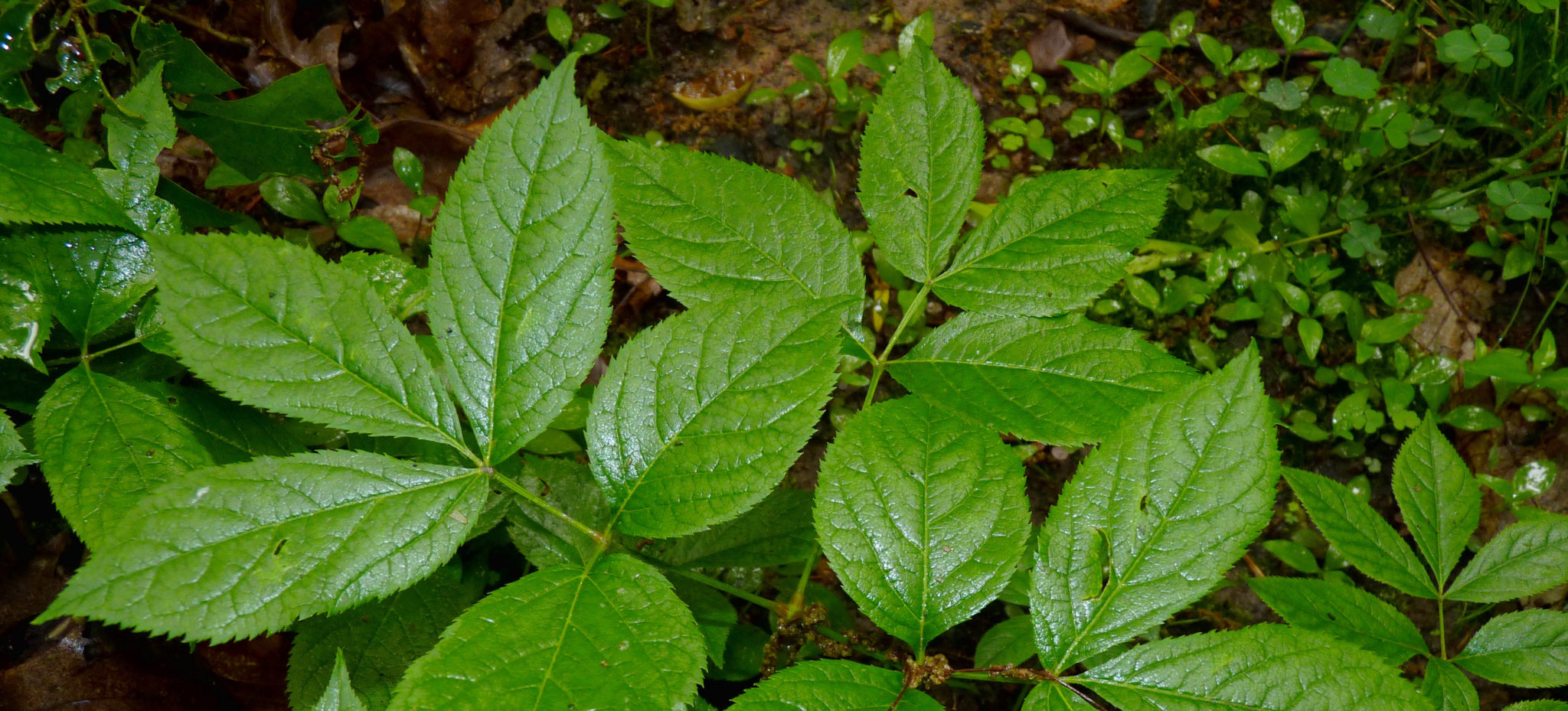
Woodland Strawberry (Fragaria vesca)
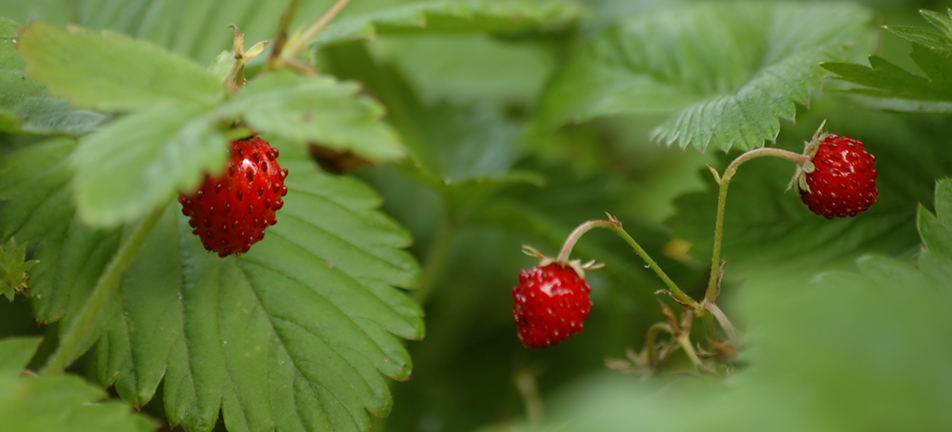
Identification
- 7.5 to 15 cm in height
- Trailing plant with dark green leaves in groups of three
- Flowers small and white with five petals; bloom in spring
Location
- Trails, roadsides, meadows, forest edges, clearings
Harvesting Time
- Late spring to early summer
Uses and Related Information
- The fruit, which ripens in June, can be made into jam, but doing so is highly labour intensive due to their small size and the large number required to make a medium sized batch of jam
- Leaves are high in vitamin C and can be used to make a subtly flavoured tea
Cautions
- Do not consume wilted leaves, which may be toxic
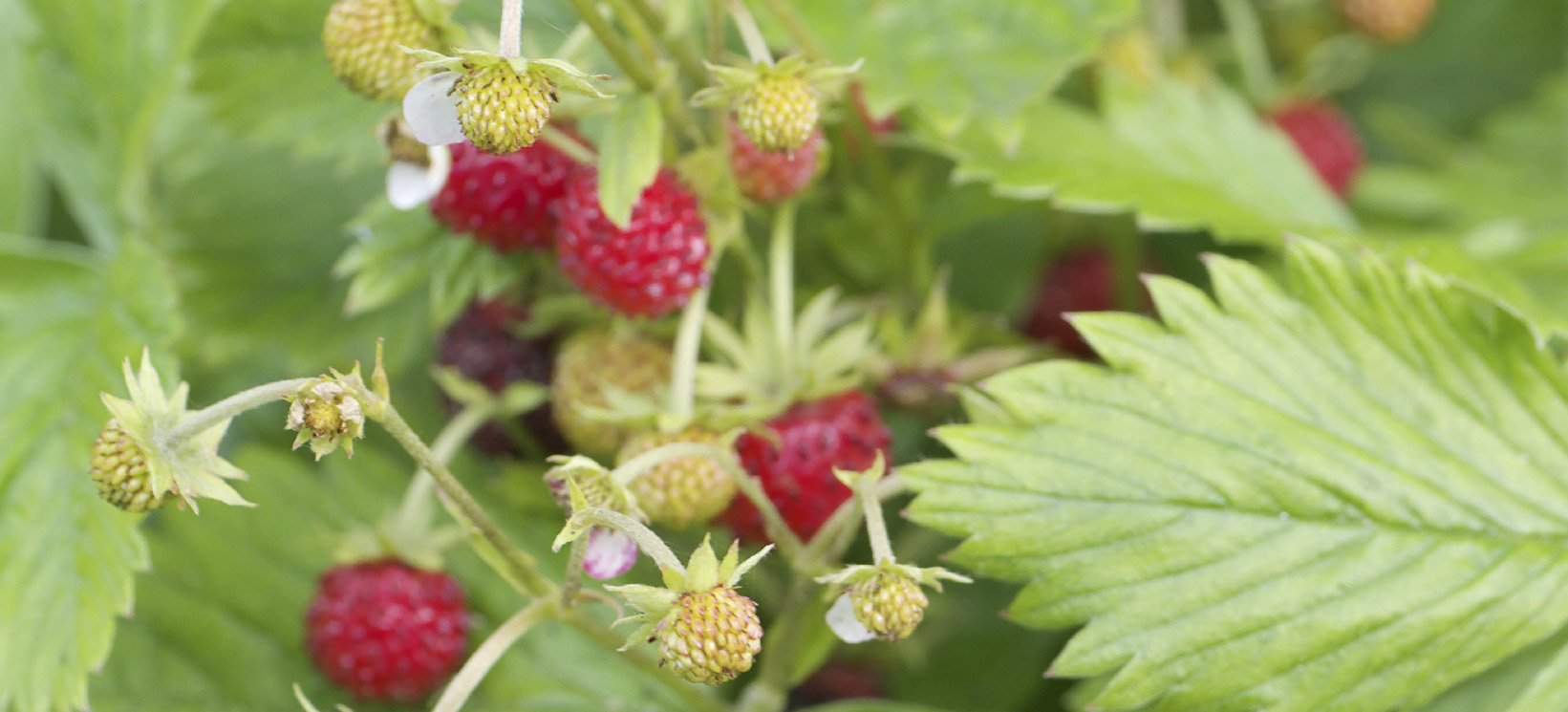
Fungi
Chanterelle (Cantharellus cibarius)
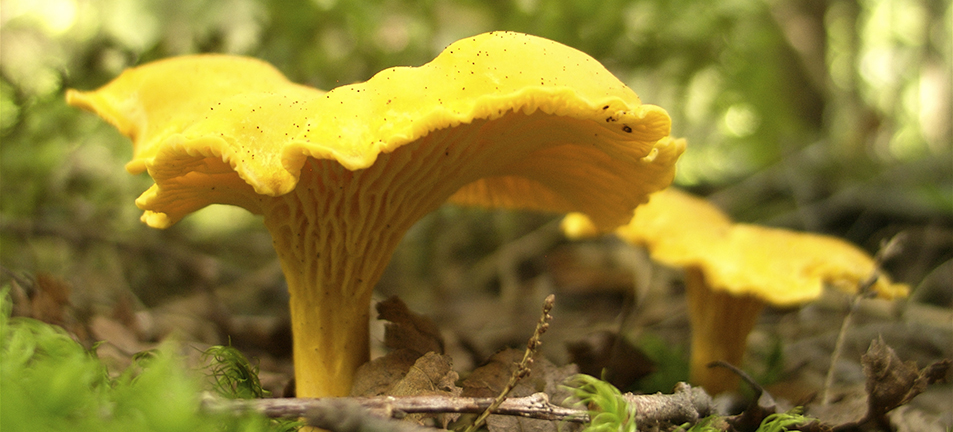
Identification
- Caps 2 to 10 cm in diameter
- Cap edge wavy (instead of smooth and flat)
- Caps and gills (long, thin tissues found under the cap) yellow to dark yellow in colour, stalk generally paler
Location
- Moist, shaded areas, near hardwoods
Harvesting Time
- Spring to summer
Uses and Related Information
- Chanterelles can be added to any dish in which mushrooms are used
- Drying chanterelles makes them tough and chewy; fresh or frozen preparations are recommended
- These mushrooms keep best if boiled in salt water and then frozen
Cautions
- Do not confuse the chanterelle with the false chanterelle (Hygrophoropsis aurantiaca), which has a significantly skinnier stalk and is orange rather than yellow
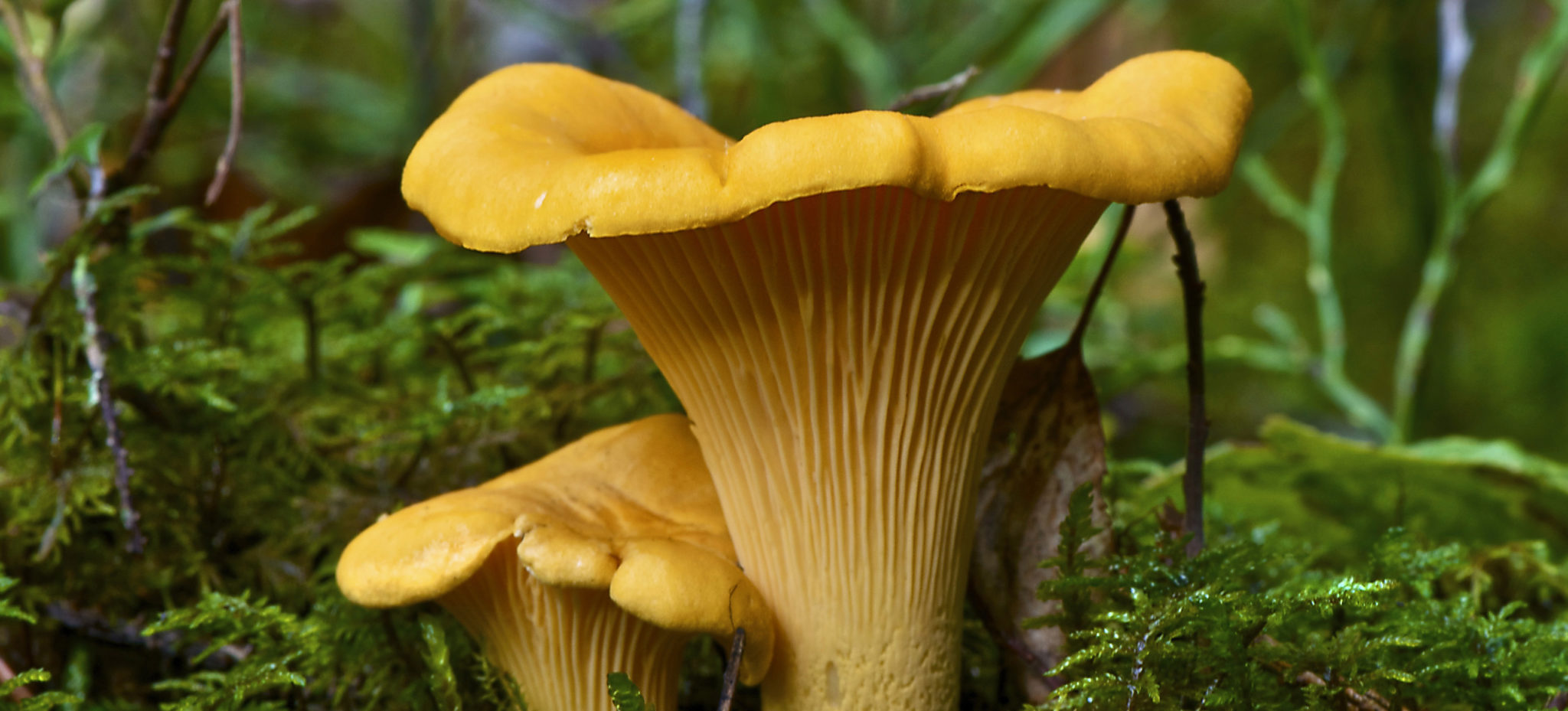
Giant Puffball (Calvatia gigantea)
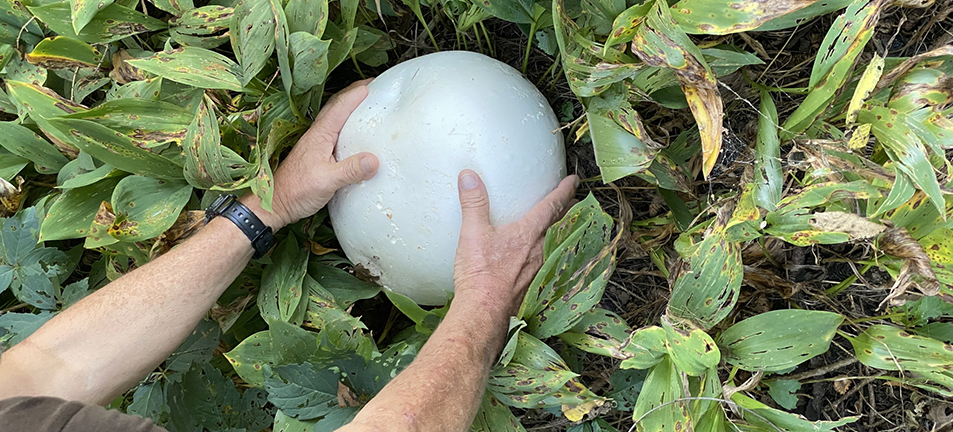
Identification
- Globose and irregular fruiting body
- Very large, up to 50 cm across
- Outer wall is smooth and white when young, turning tan to cinnamon as it gets older
- When cut open, the center will be entirely white and uniform in texture, with no silhouette of gills
Location
- Nutrient rich soil locations such as woodlands, fields, streambanks and gardens
Harvesting Time
- Late summer to early fall
Uses and Related Information
- Referred to as breakfast mushrooms by some as they can be mixed with eggs well
- Slabs of this mushroom can be served as a side dish, and brown well when fried in butter
- Preserving this mushroom can be done by chopping, sautéing and then freezing
Cautions
- Insides must be white when harvested, as any shade of yellow or purple can cause intestinal discomfort
- The outer covering of this mushroom may also cause discomfort, and it is recommended to peel and discard it

Honey Mushroom (Armillaria mellea)
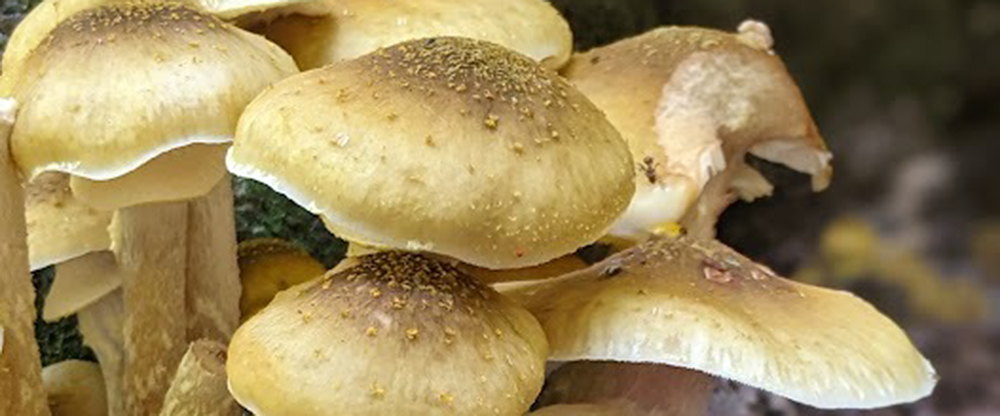
Identification
- Caps are 3 – 10 cm across, convex and flat with a pale yellow-brown to tan colouration, sometimes appearing sticky on top
- Scales may appear on the cap, often near the center
- Stalks are 15 cm tall and 2 cm wide, with a distinct white flared ring
- Gills are short-decurrent
Location
- In moist forest areas, on logs or near stumps
Harvesting Time
- Late fall
Uses and Related Information
- Only the caps are edible, as the stems are tough and fibrous
- Has a firm, meaty texture that keeps its shape even when cooked
- Used in soups and stews when dried and rehydrated
Notes
- Some experience a mild bitter aftertaste, but this can be alleviated by parboiling the caps for about 5 minutes and discarding the water
- This species can emanate a bioluminescent glow called “fox fire”
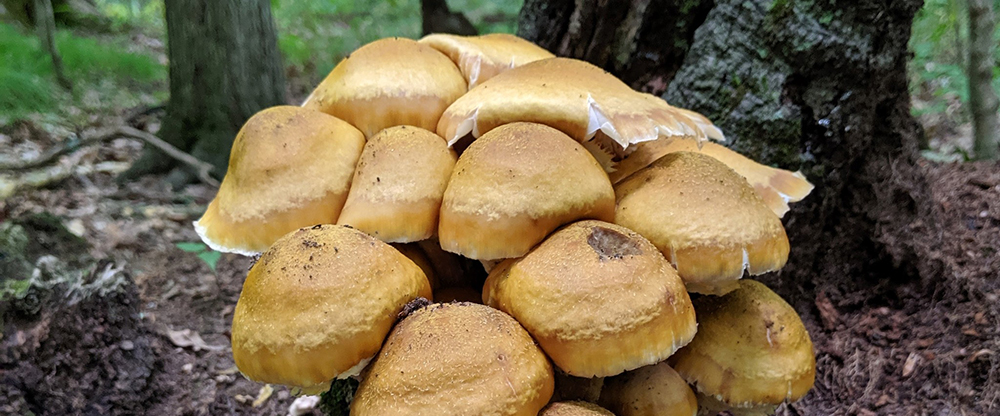
Lobster Mushroom (Hypomyces lactifluorum)
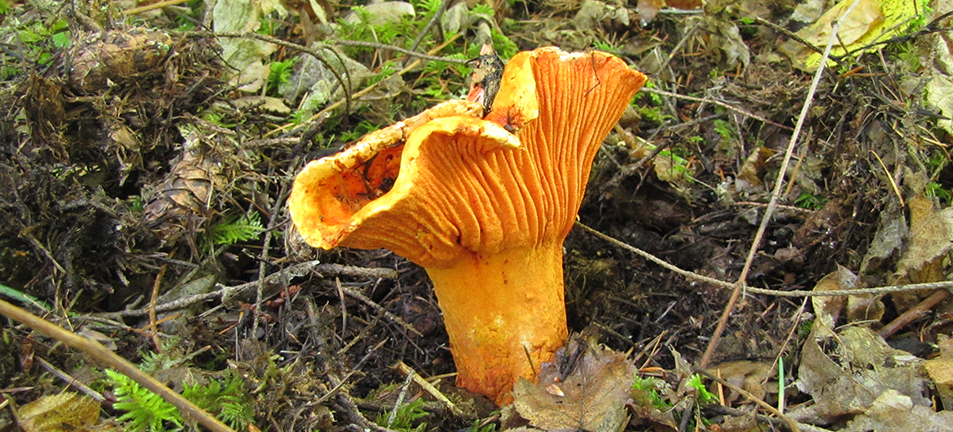
Identification
- Cap size around 5 to 12 cm, though this is based on the original mushroom parasitized
- Bright orange mushroom with firm cap and stem
- Irregular or semi-deformed appearance
- Lobster mushrooms result from a relationship between Lactarius mushrooms and a parasite; this parasite turns the mushrooms bright orange and affects the shape and growth
Location
- Wooded areas
Harvesting Time
- Midsummer
Uses and Related Information
- Lobster mushrooms can be sliced and pan-fried in butter, and pair well with soy sauce or other Asian sauces
- They should be firm and white inside, not grey, soft or spotted
- Part of the mushroom cap may need to be removed to get rid of all dirt
- They can be dried and stored
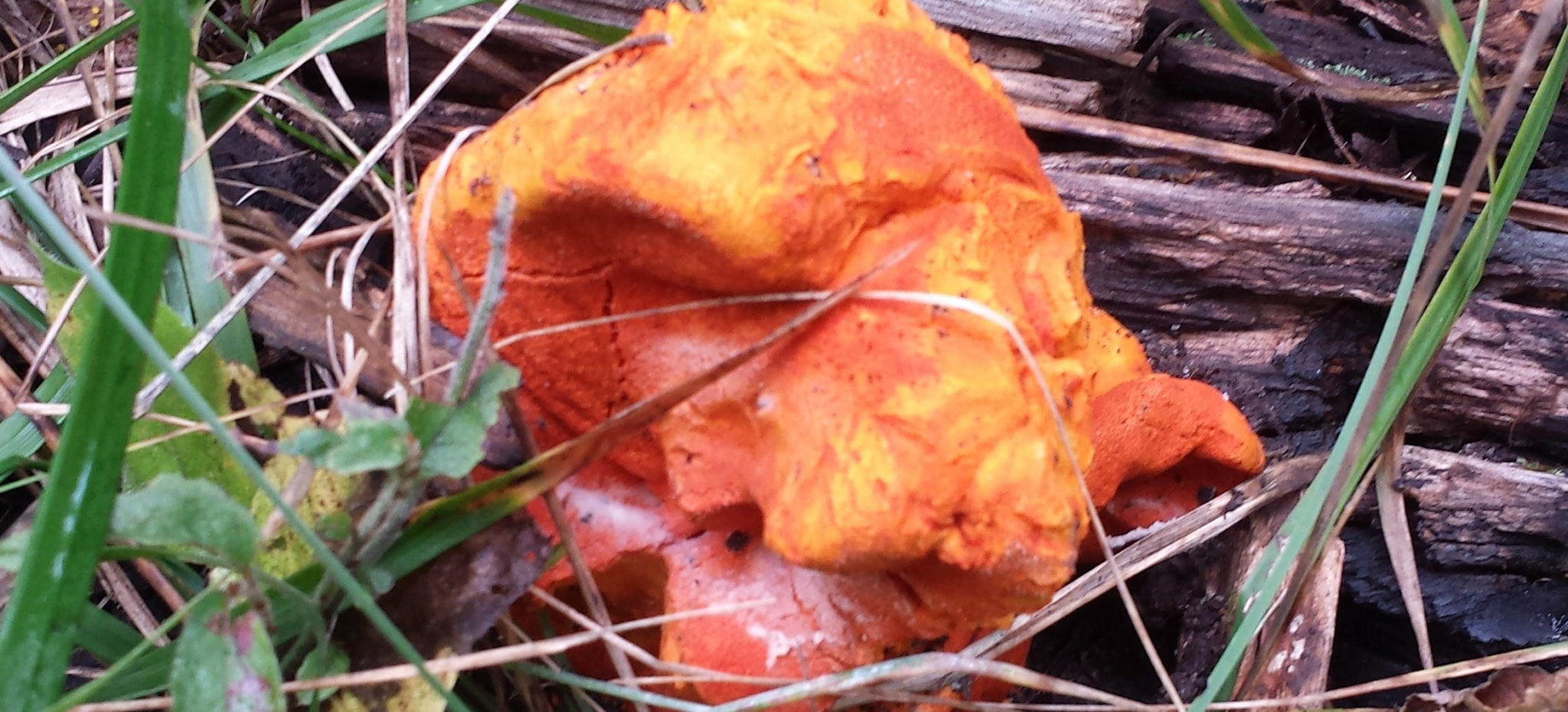
Morel (Morchella spp.)
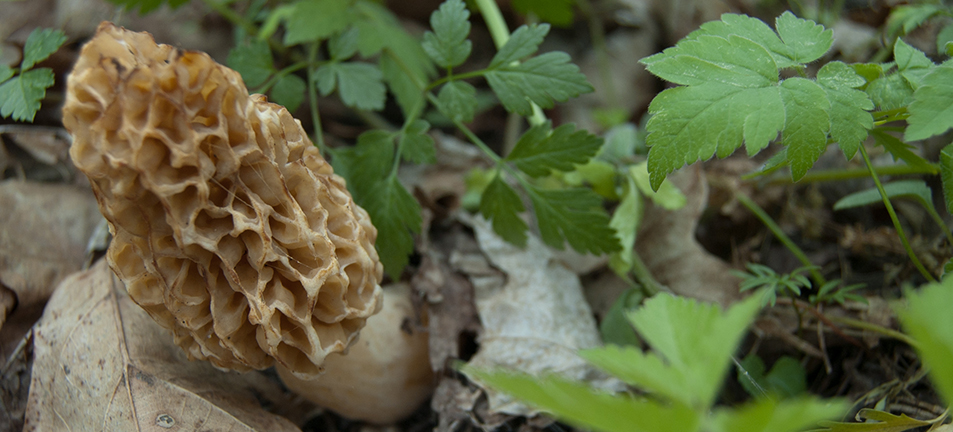
Identification
- Heads are long (conical or ellipsoid in shape) with a series of ridges and pitted chambers
- Hollow inside from tip of cap to bottom of stalk
Location
- Forests, open meadows and highly disturbed (e.g. burned or grazed) landscapes
Harvesting Time
- Spring
Uses and Related Information
- Morels, which have a meaty flavour even when they have been dried, make great stuffed mushrooms and pair well with butter or light cream sauces
- Dried morels can be stored for a relative long amount of time and should be rehydrated in hot water before use
Cautions
- Do not confuse the morel for the poisonous false morel, which is not hollow on the inside; always confirm identification by consulting guides, images and experts
- Do not eat raw morels
- Cook morels very thoroughly, to avoid any stomach pain or discomfort
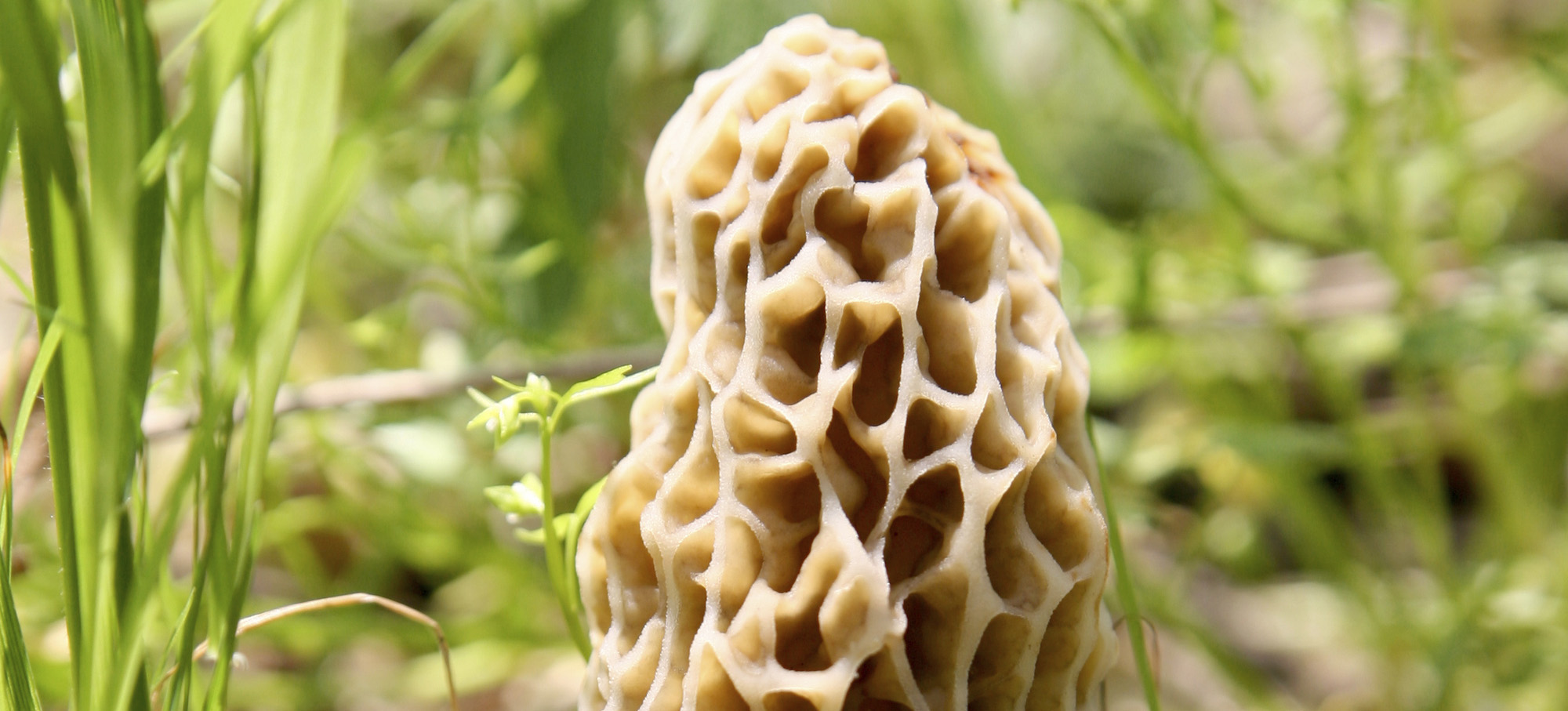
Acknowledgements
Ontario Nature would like to acknowledge all of the experts consulted during the preparation of this guide. They are listed at the back of the guide, along with other resources. Additionally, the guide includes Indigenous knowledge about using and preparing plants, and Ontario Nature thanks Indigenous knowledge holders for their sharing and contribution.
Experts Consulted
- Gammond, Pete: Wild food enthusiast, who focuses on edible and practical applications of plants
- Moses, Raphael: Traditional elder in northwestern Ontario, who focuses on traditional uses of plants (both medicinal and edible) by Indigenous people
- Reeves, Laura: Botanist/wild food enthusiast, who focuses on increasing public knowledge of and respect for the beauty, diversity and usefulness of wild plants
- St. Amand, Dave: Local mushroom expert, who focuses on edible wild mushrooms
- Stephenson, Karen: Owner of ediblewildfood.com, who focuses on nutritional aspects of plants, as well as both medicinal and edible applications
Publications
- Barron, G. 1999. Mushrooms of Ontario and Eastern Canada. Lone Pine Publishing. Edmonton, Alberta.
- Boulet, A. et al. 2014. Beyond the Fields: The value of forest and freshwater foods in northern Ontario. Ontario Nature.
- Evergreen. 2014. Can Plan.can-plant.ca.
- Freedman, L. 1991. Wild about Mushrooms: The Mycological Society of San Francisco cookbook. Addison-Wesley. mssf.org/cookbook.
- Gibson, W.H. 1895. Our Edible Toadstools and Mushrooms and How to Distinguish Them. Library of Alexandria Publishing. Ithaca, New York.
- Gray, B. 2011. The Boreal Herbal: Wild food and medicine plants of the north (A guide to harvesting, preserving and preparing). Aroma Borealis Press. Whitehorse, Yukon.
- Legasy, K., S. Labelle-Beadman and B. Chambers. 1995. Forest Plants of Northeastern Ontario. Lone Pine Publishing. Edmonton, Alberta.
- Lincoff, G. 2011. The Complete Mushroom Hunter: An illustrated guide to finding, harvesting and enjoying wild mushrooms. Quarry Books. Beverly, Massachusetts.
- MacKinnon, A., L. Kershaw, J.T. Arnason, P. Owen, A. Karst and F. Hamersley Chambers. 2009. Edible and Medicinal Plants of Canada. Lone Pine Publishing. Edmonton, Alberta.
- Minnesota Forest Stewardship Program et al. Balsam Bough – Careful Harvest Fact Sheet. U.S. Forest Service. files.dnr.state.mn.us/forestry/um/carefulharvest_brochure.pdf.
- Reeves, L. 2011. Laura’s Guide to Useful Plants: From acorns to zoom sticks. Laura Reeves. Manitoba.
- Stephenson, K. 2012. Fields of Nutrition. Ontario.

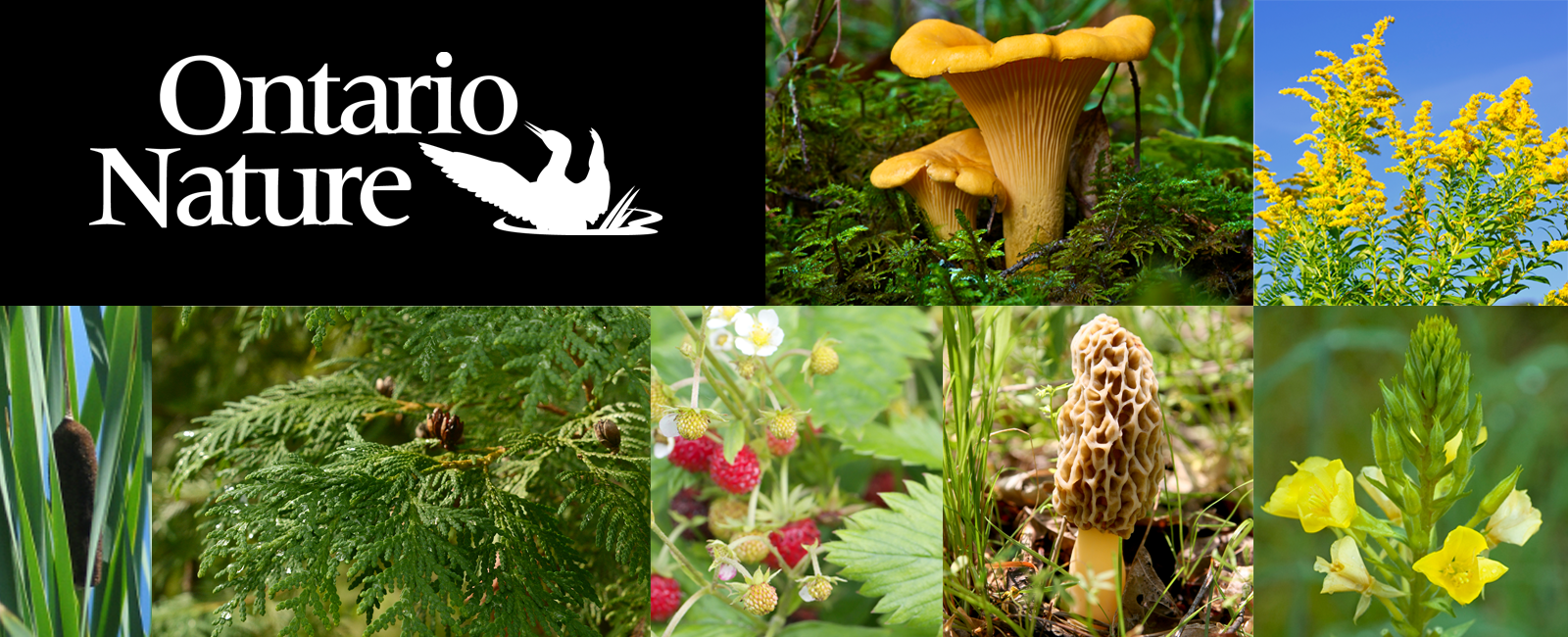

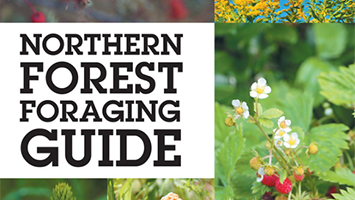
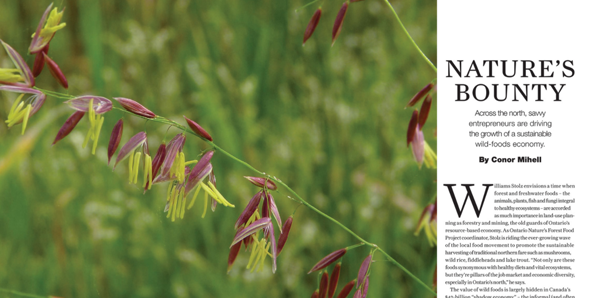


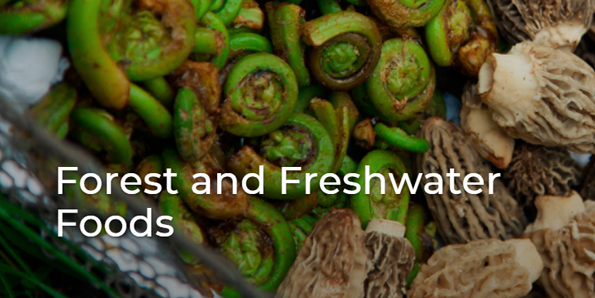
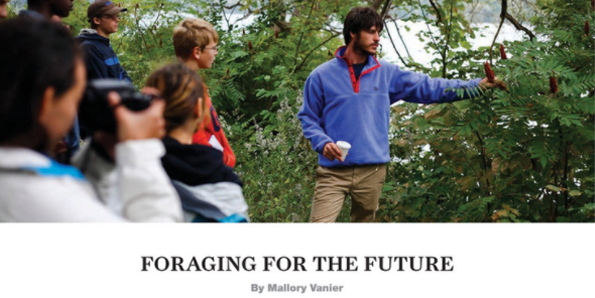


[…] more resources, watch the documentary Forage on CBC Gem, visit Ontario Nature Forest Foraging Guide or download the apps iNaturalist and Plant Snap. You can also follow Alexis Nikole (@blackforager) […]
hi could i buy the paperback? thanks.
Hi MJ,
There is no print or paperback version at the moment.
Though, you’re welcomed to download and print this PDF guide.
ON Noah
Mullein and Plantain are well-known soothing teas for LUNG irritation (steep 20 min to an hour) as well: I found it very effective during this wildfire season! And broadleaf plantain (plantago) is a fantastic in-the-field antidote for stinging nettle stings (and they almost always grow near each other!) Just chew up the leaf a bit, and put the mushy leaf bits on affected skin, and you’ll notice immediate relief. You can always identify Plantain/Plantago by the long vertical lines in the leaves that start at the base, and meet again at the tip. Most effective used within 5-15 minutes of a nettle sting – if you brush up against or touch nettles, look around for Plantain right away.
Nettles are N. America’s superfood: twice as much calcium as the same amount of milk, much higher mineral content than spinach or kale.